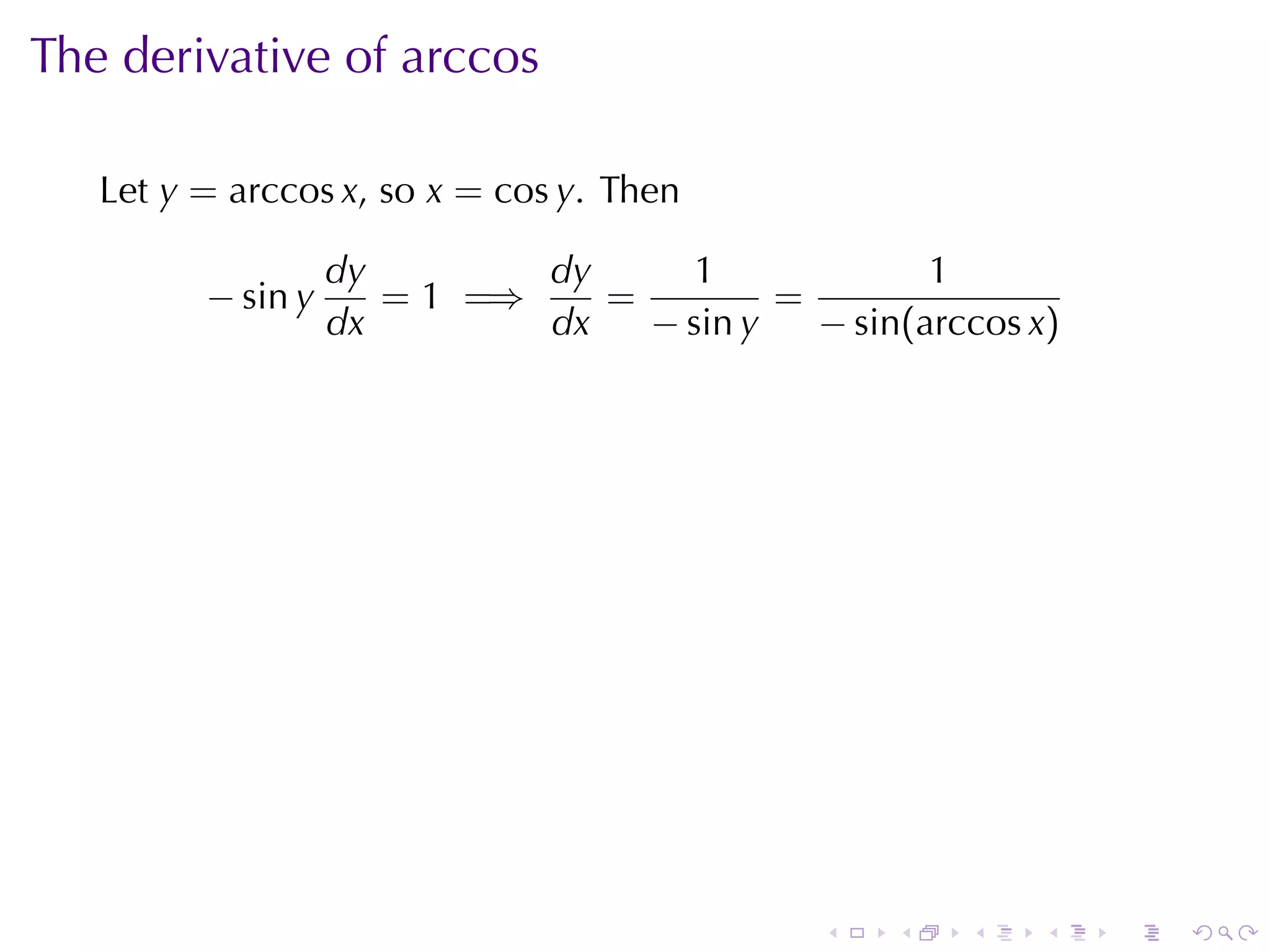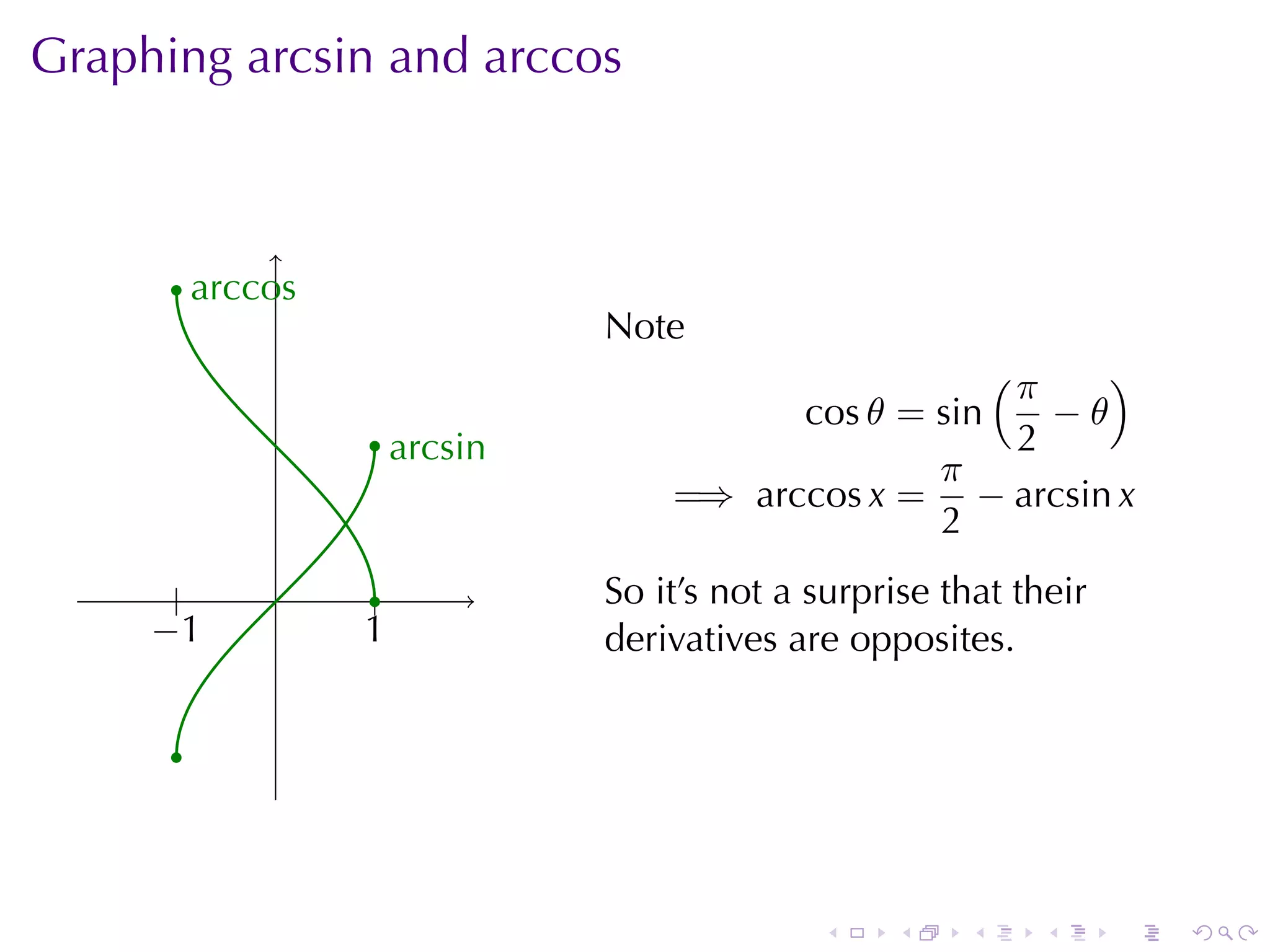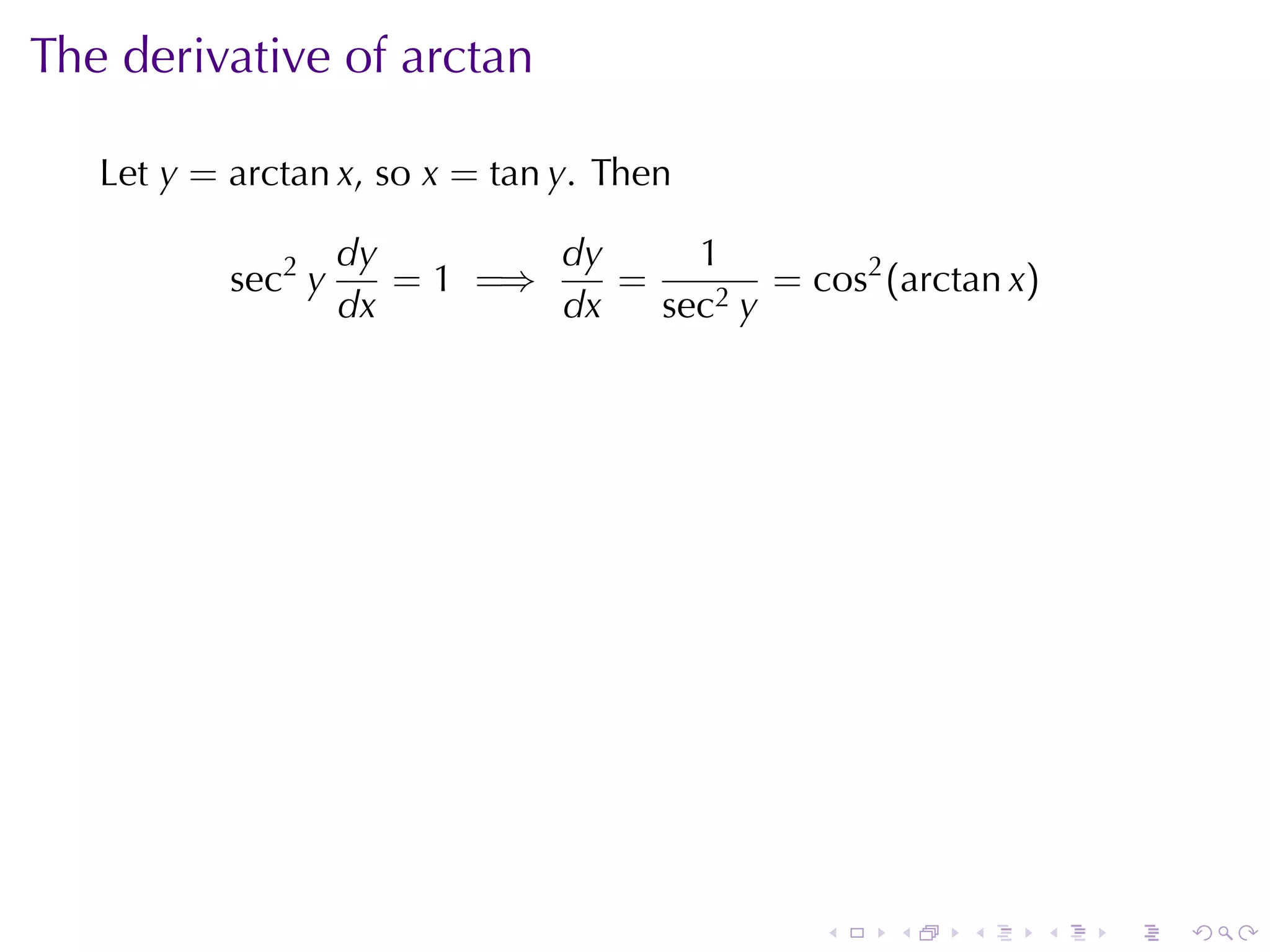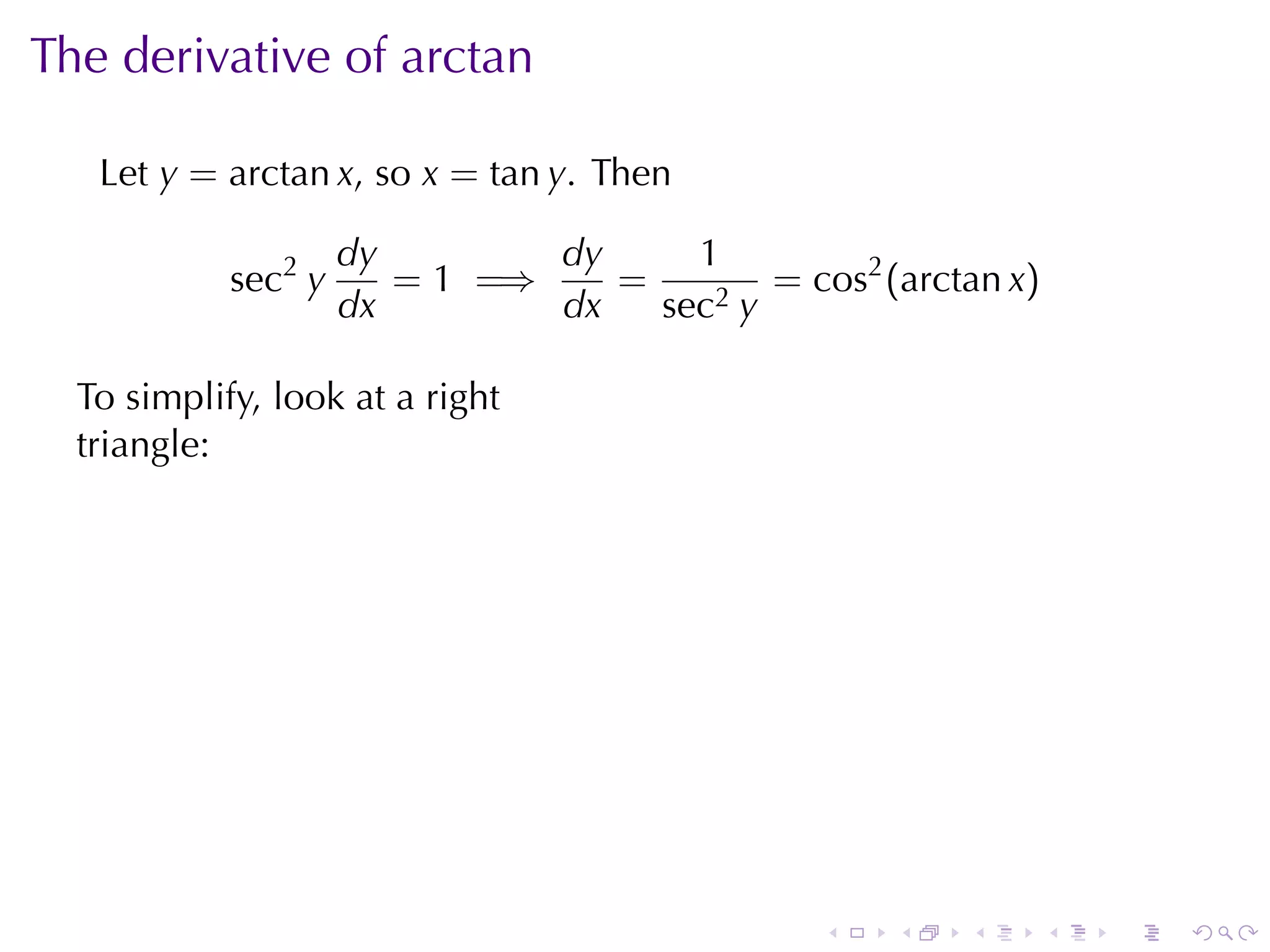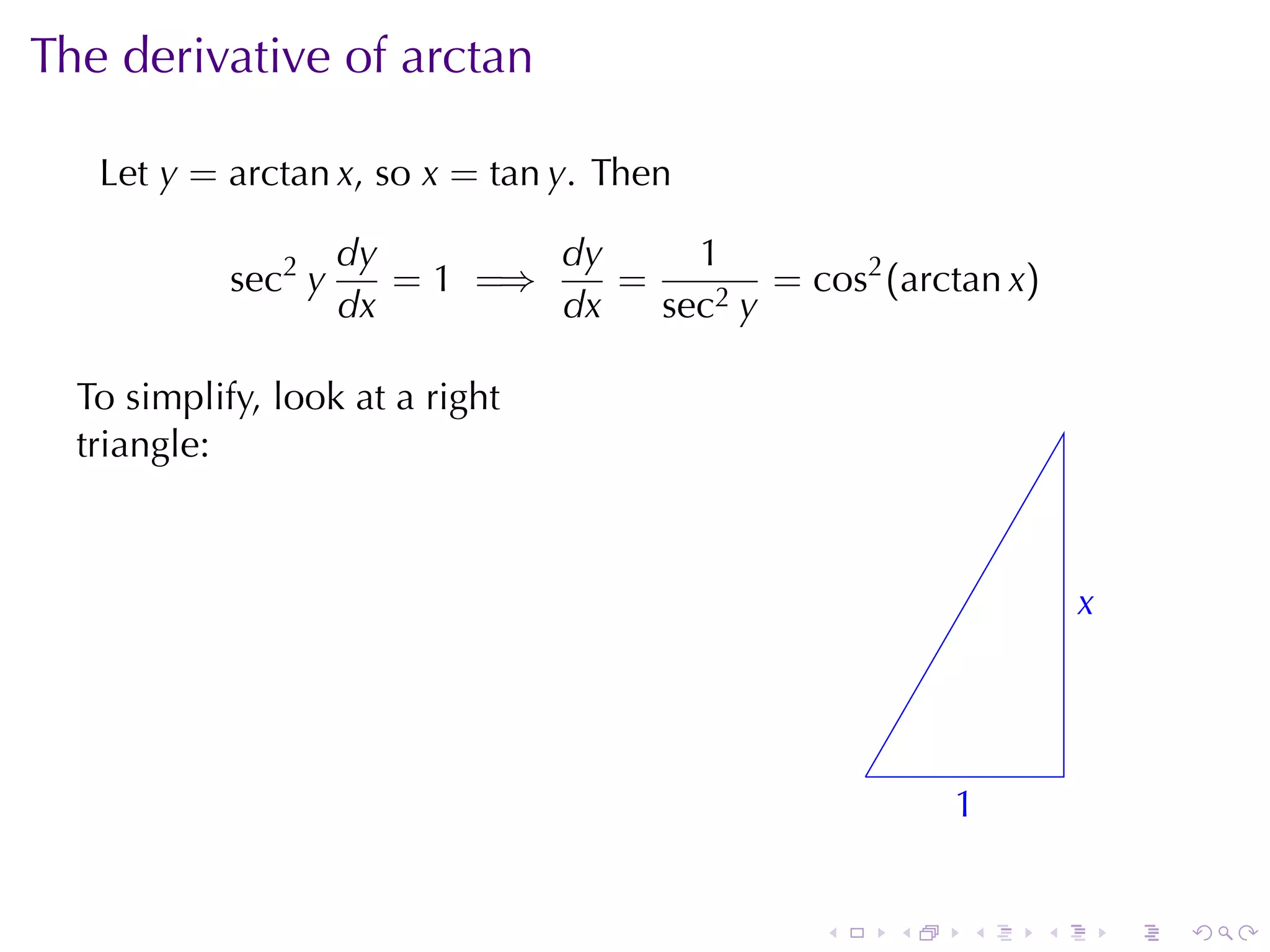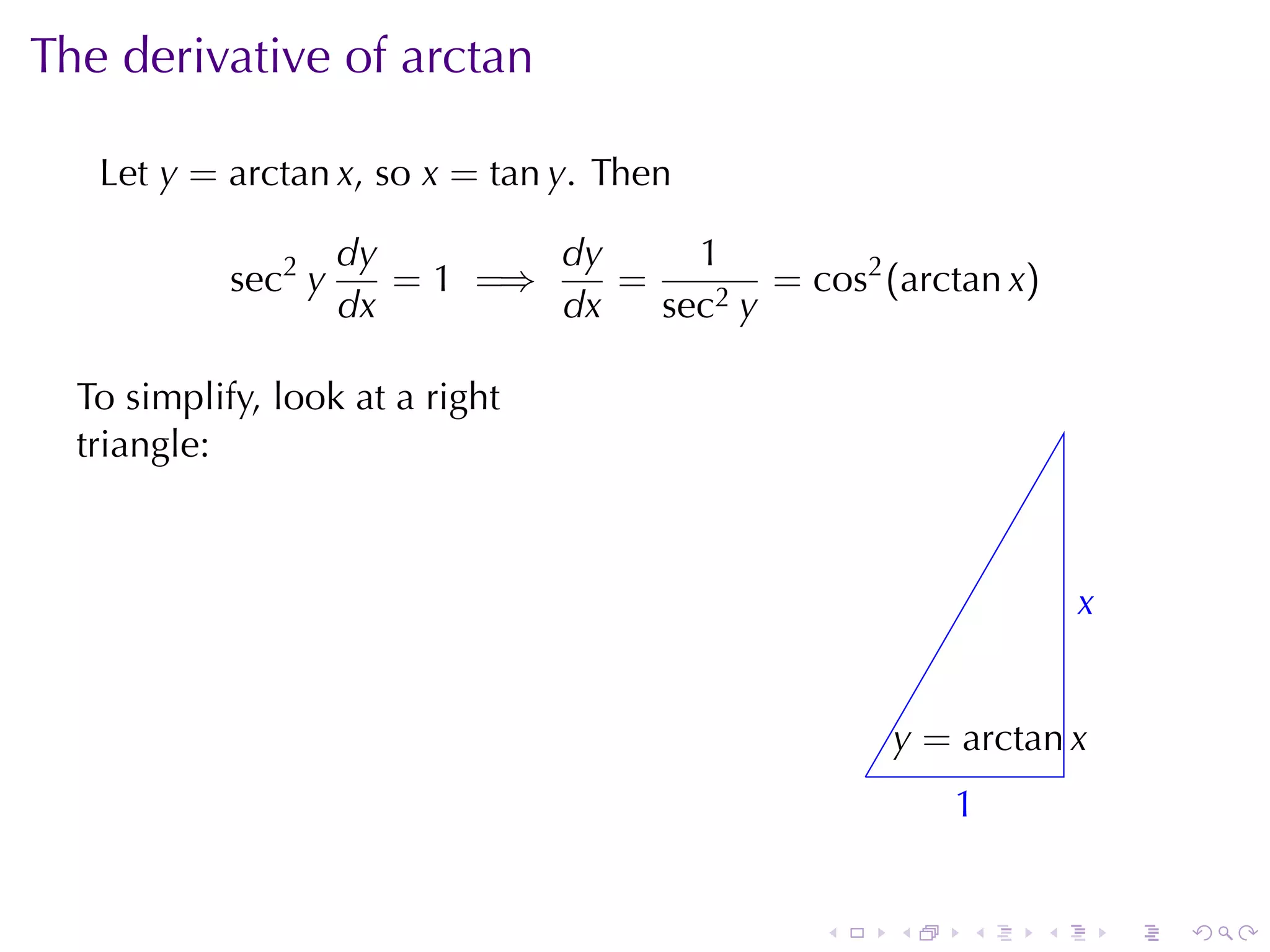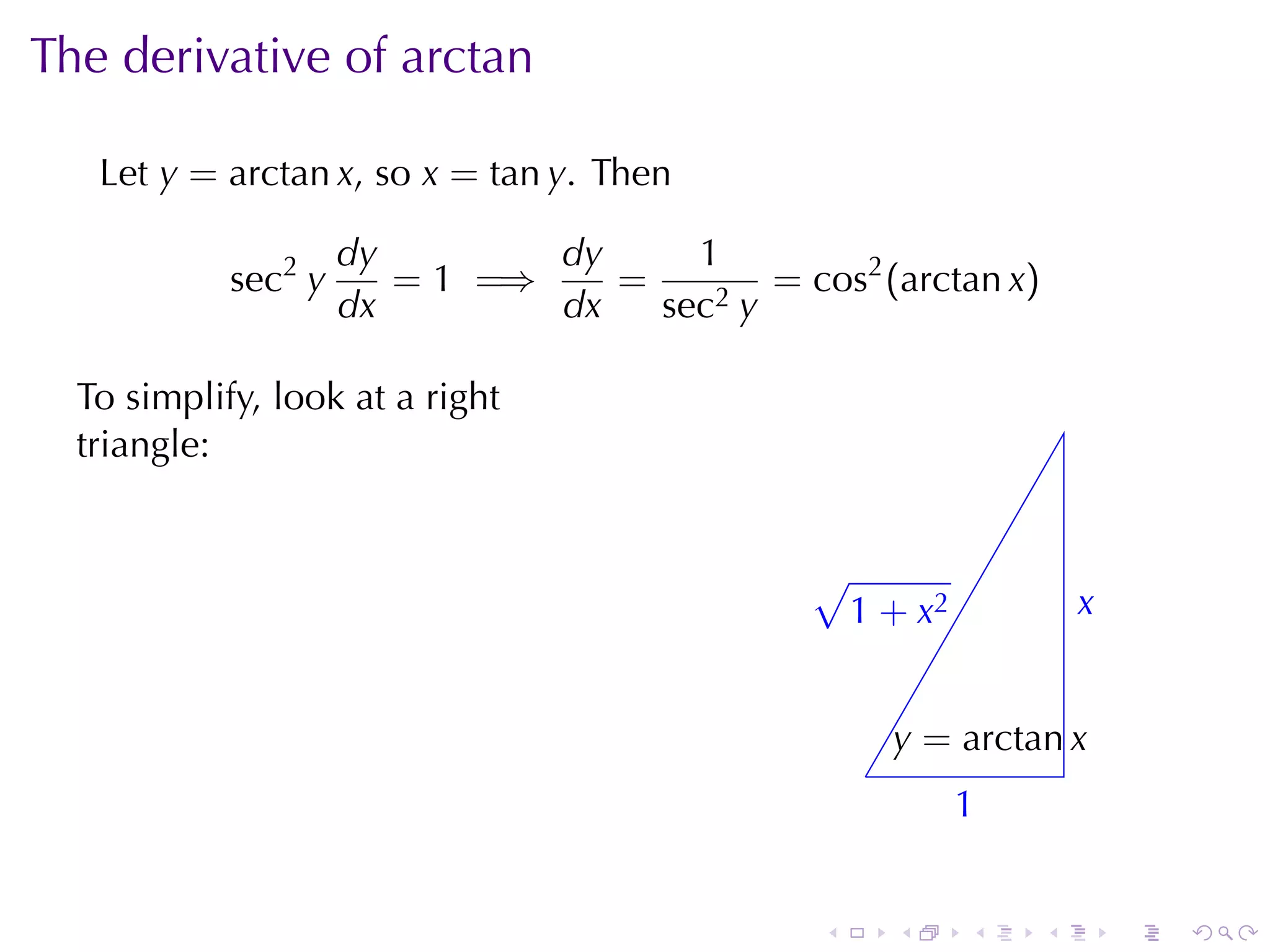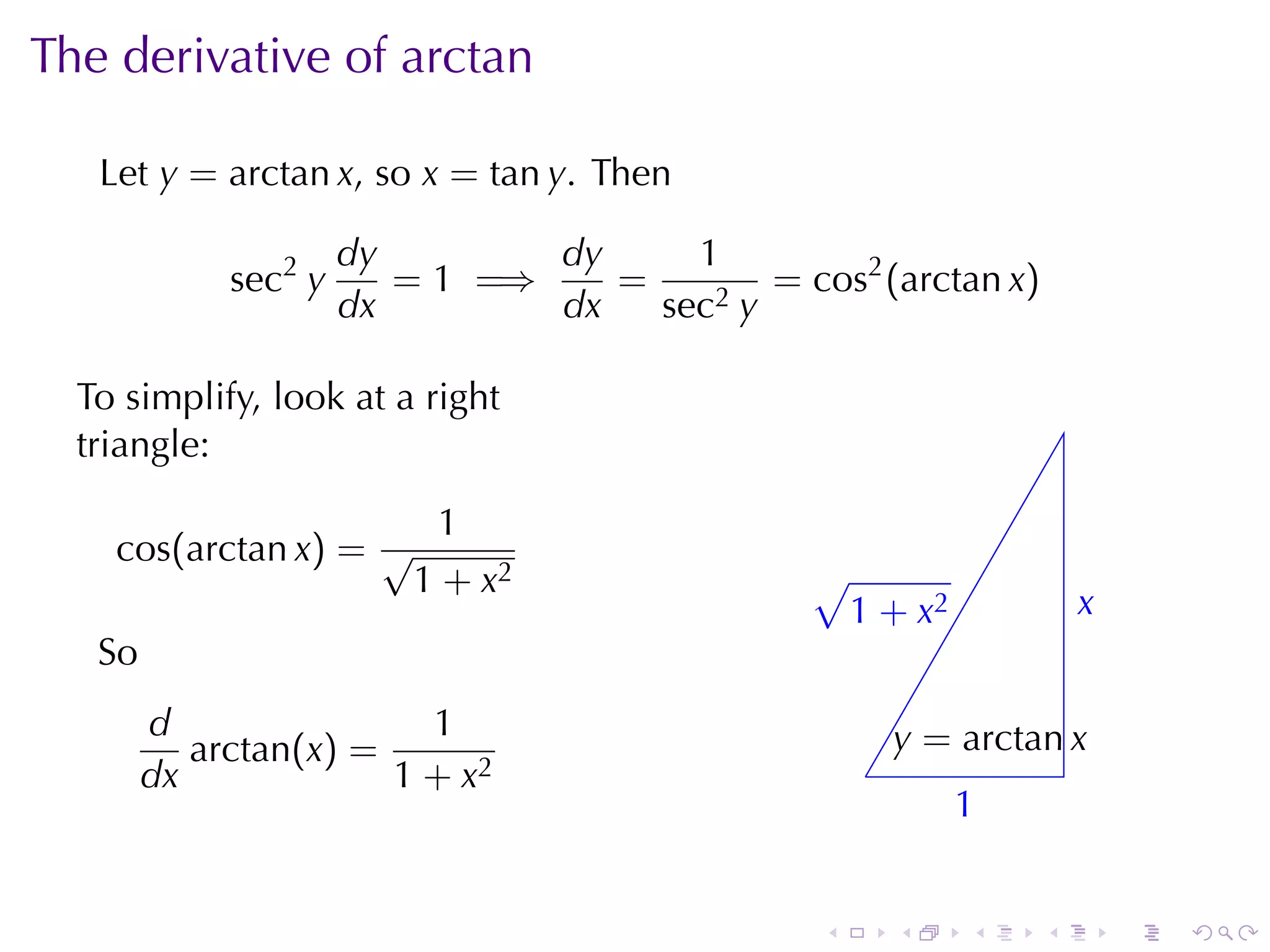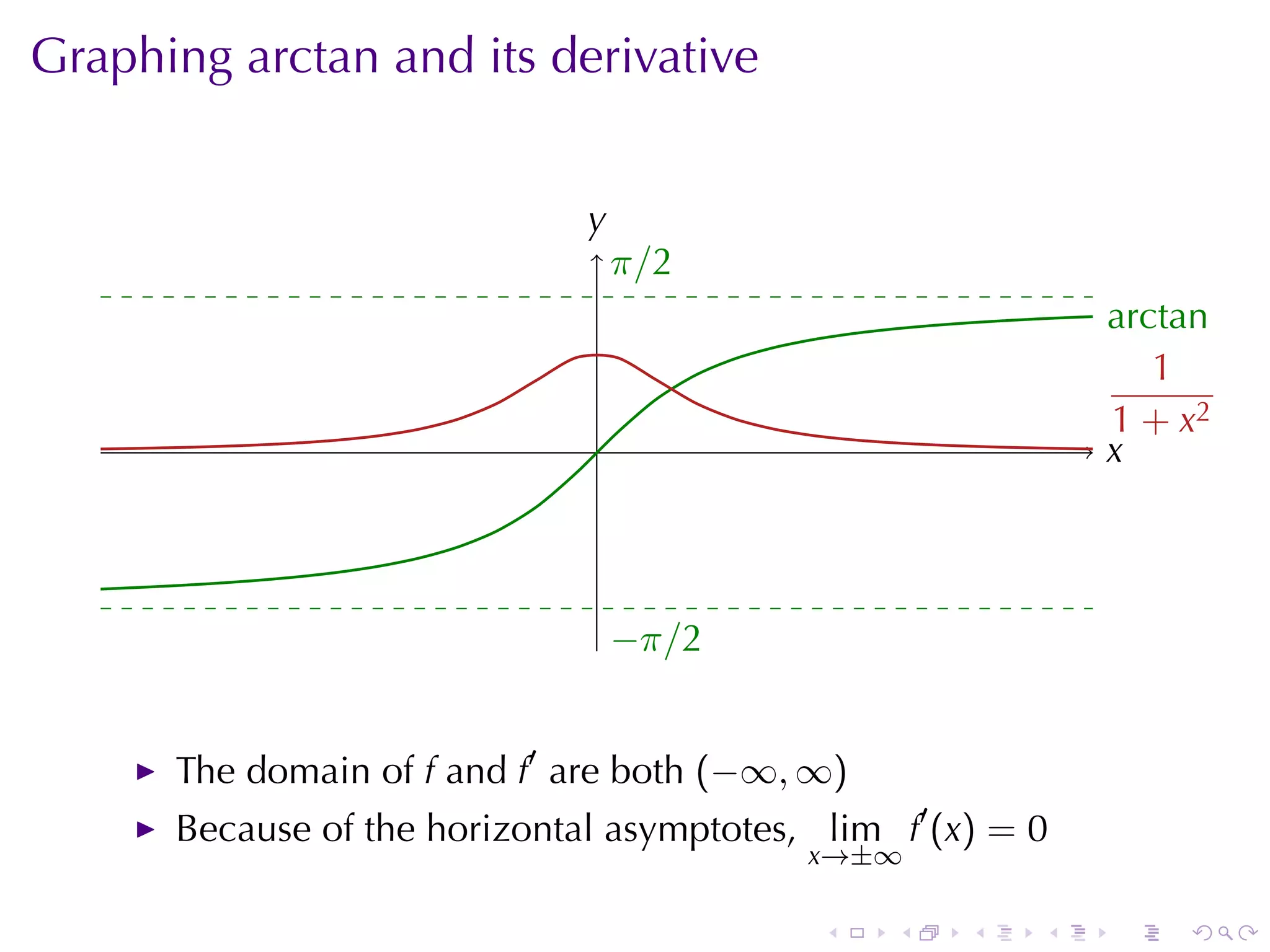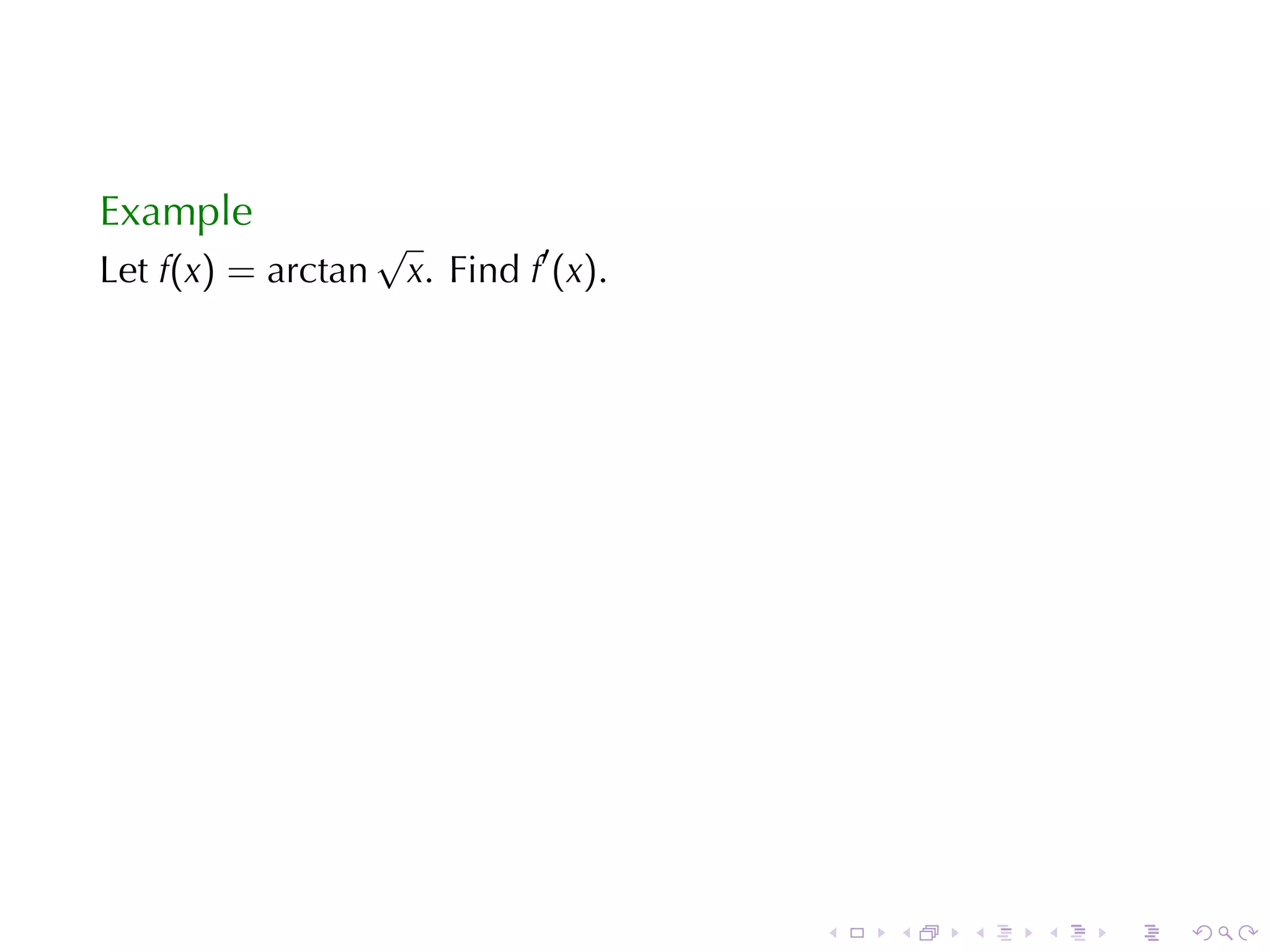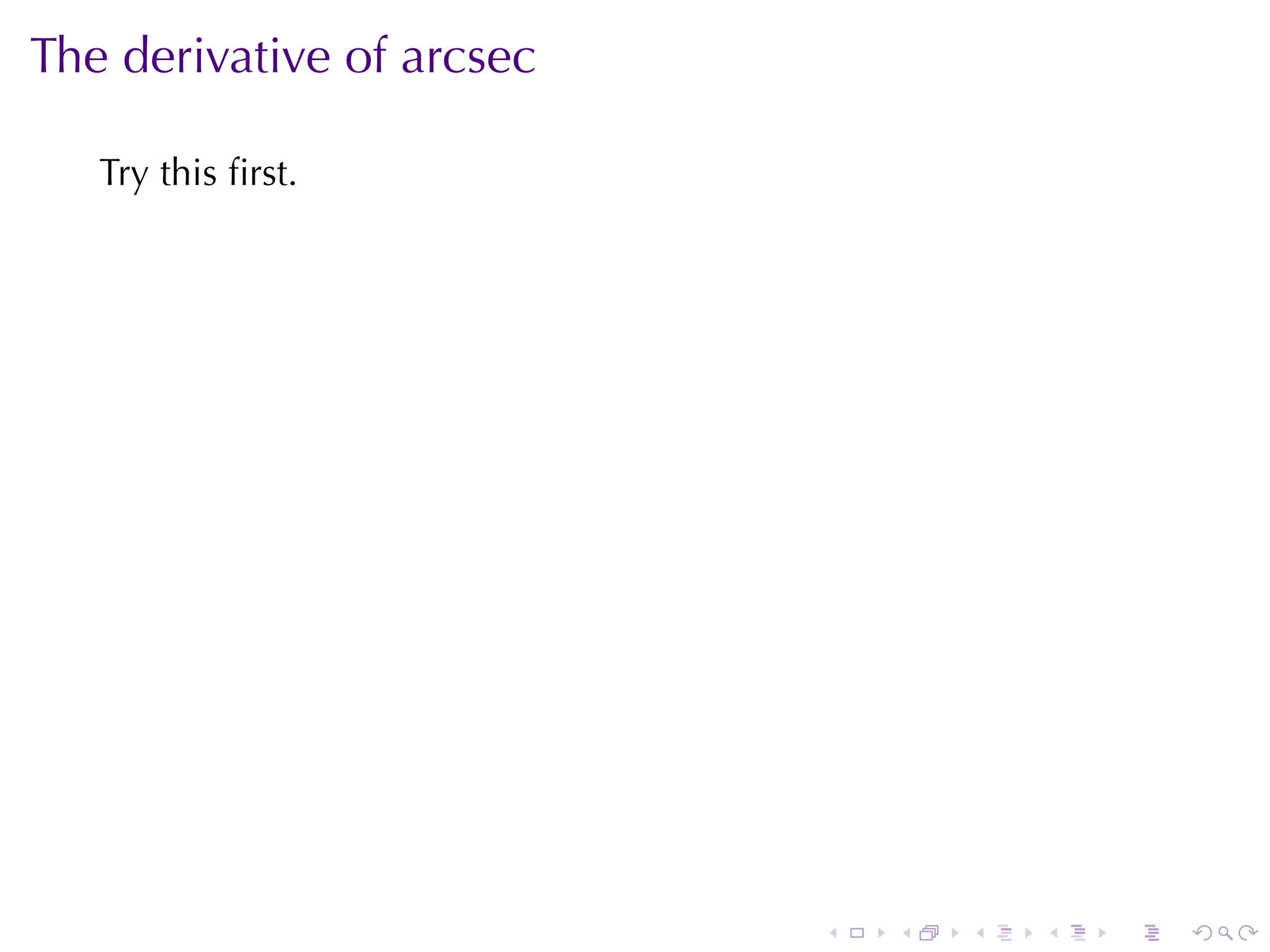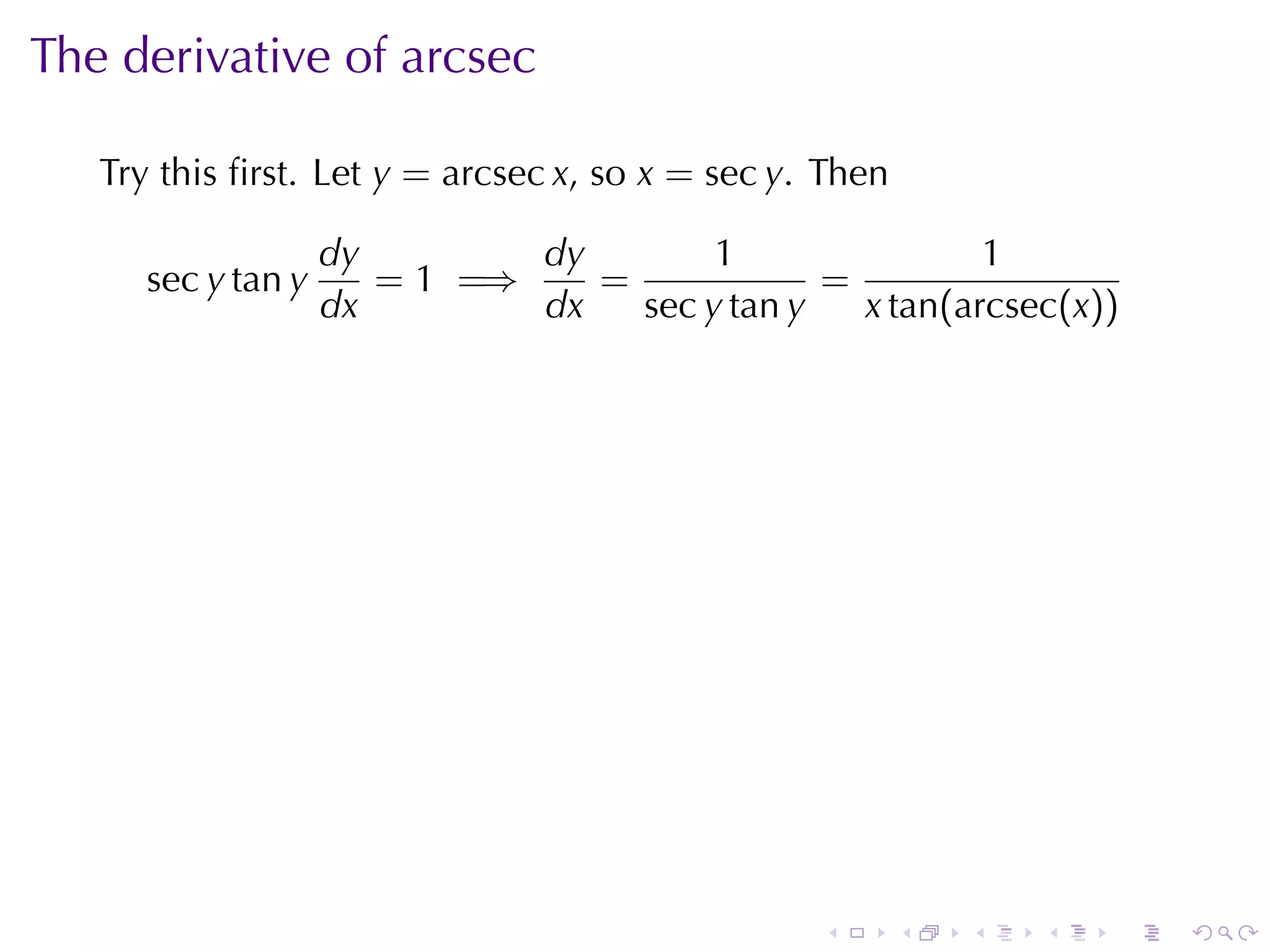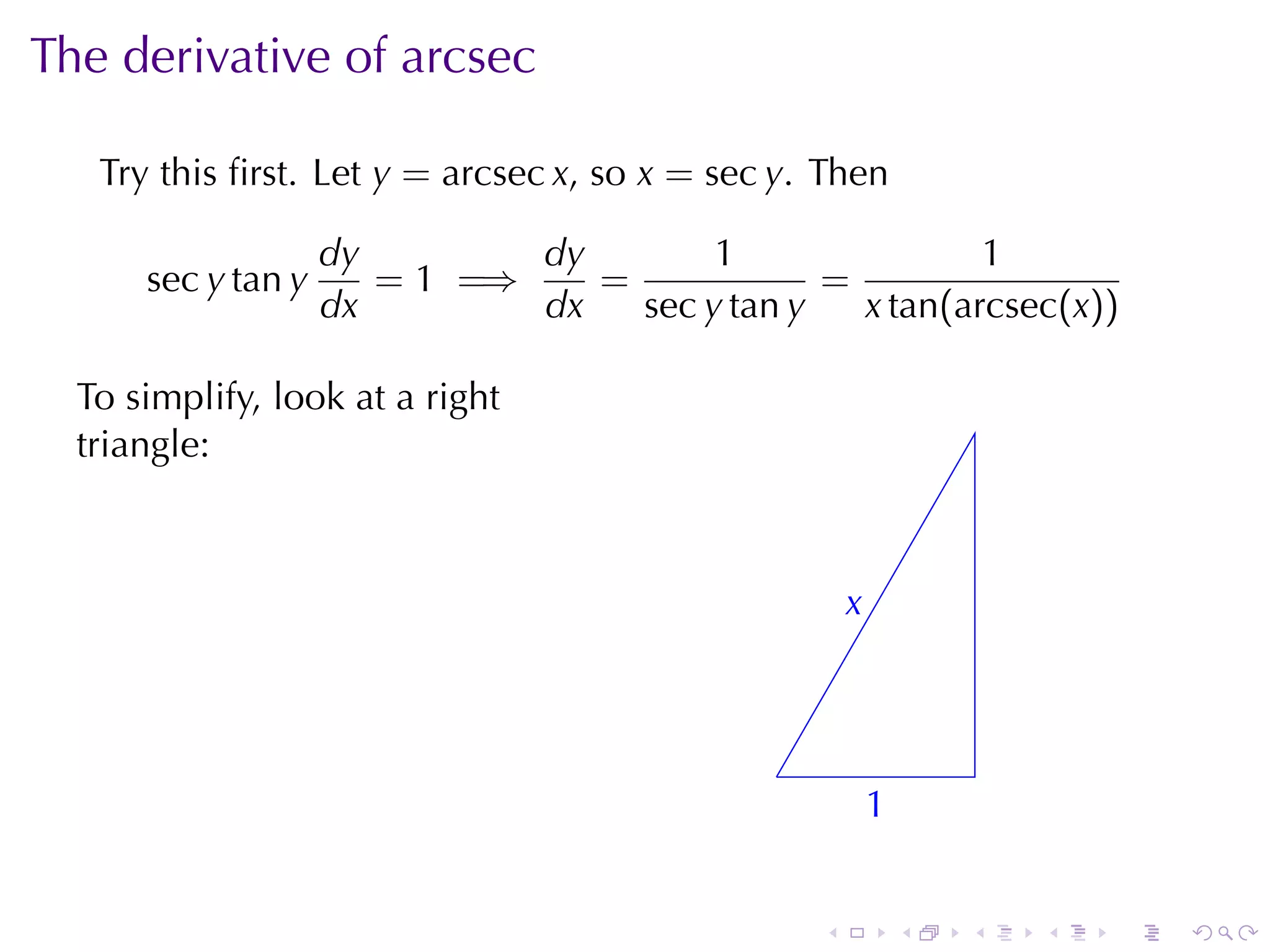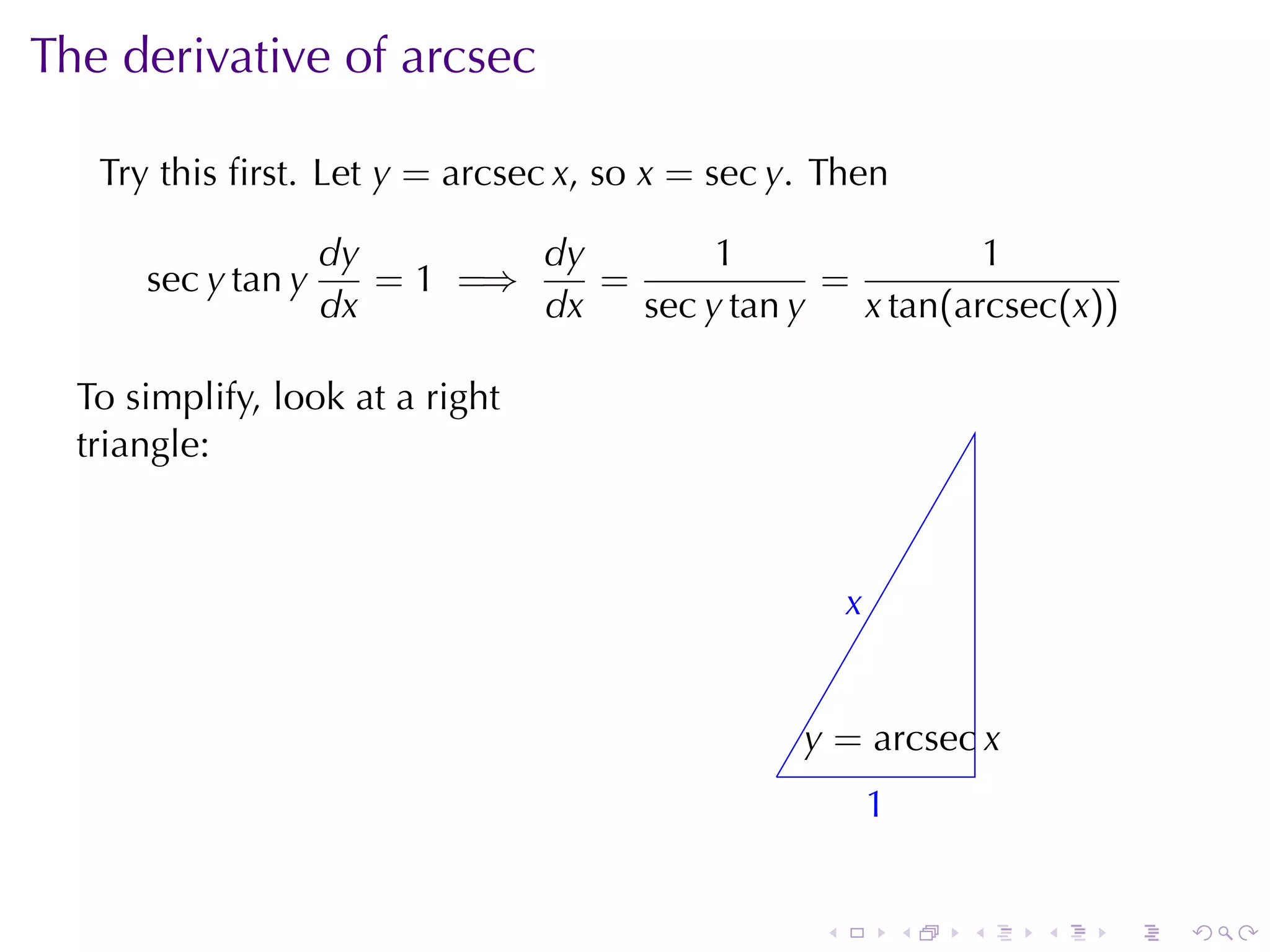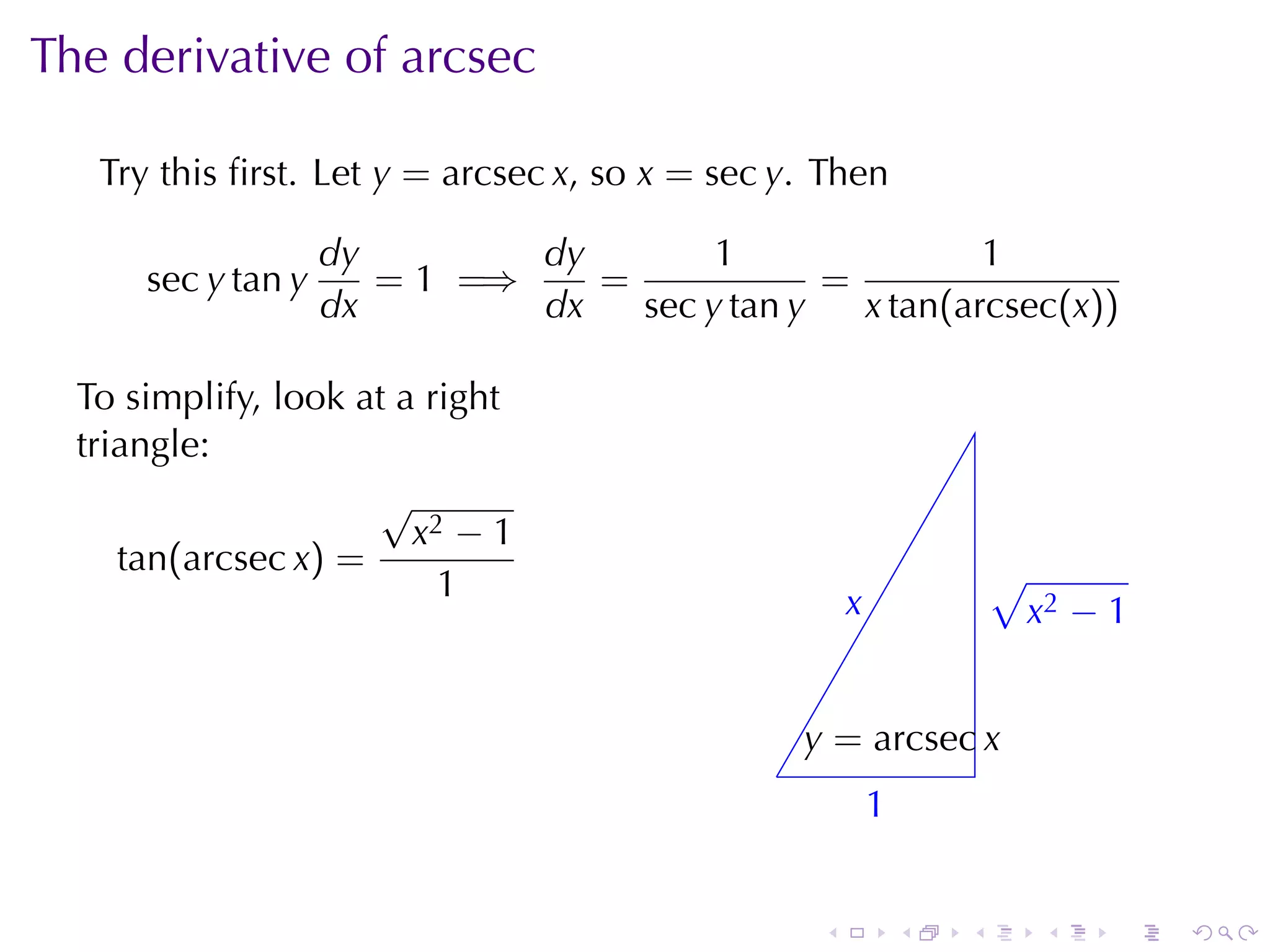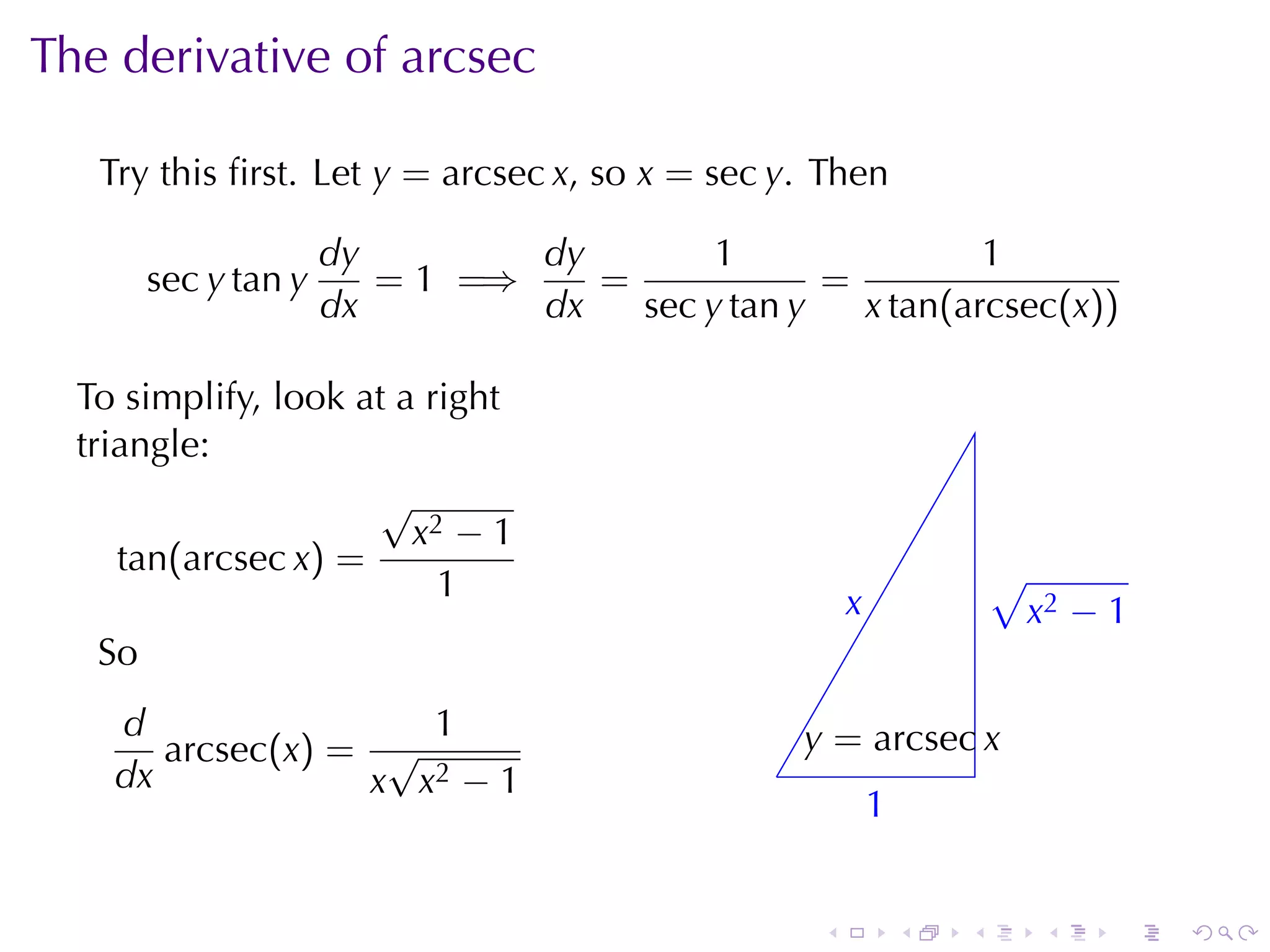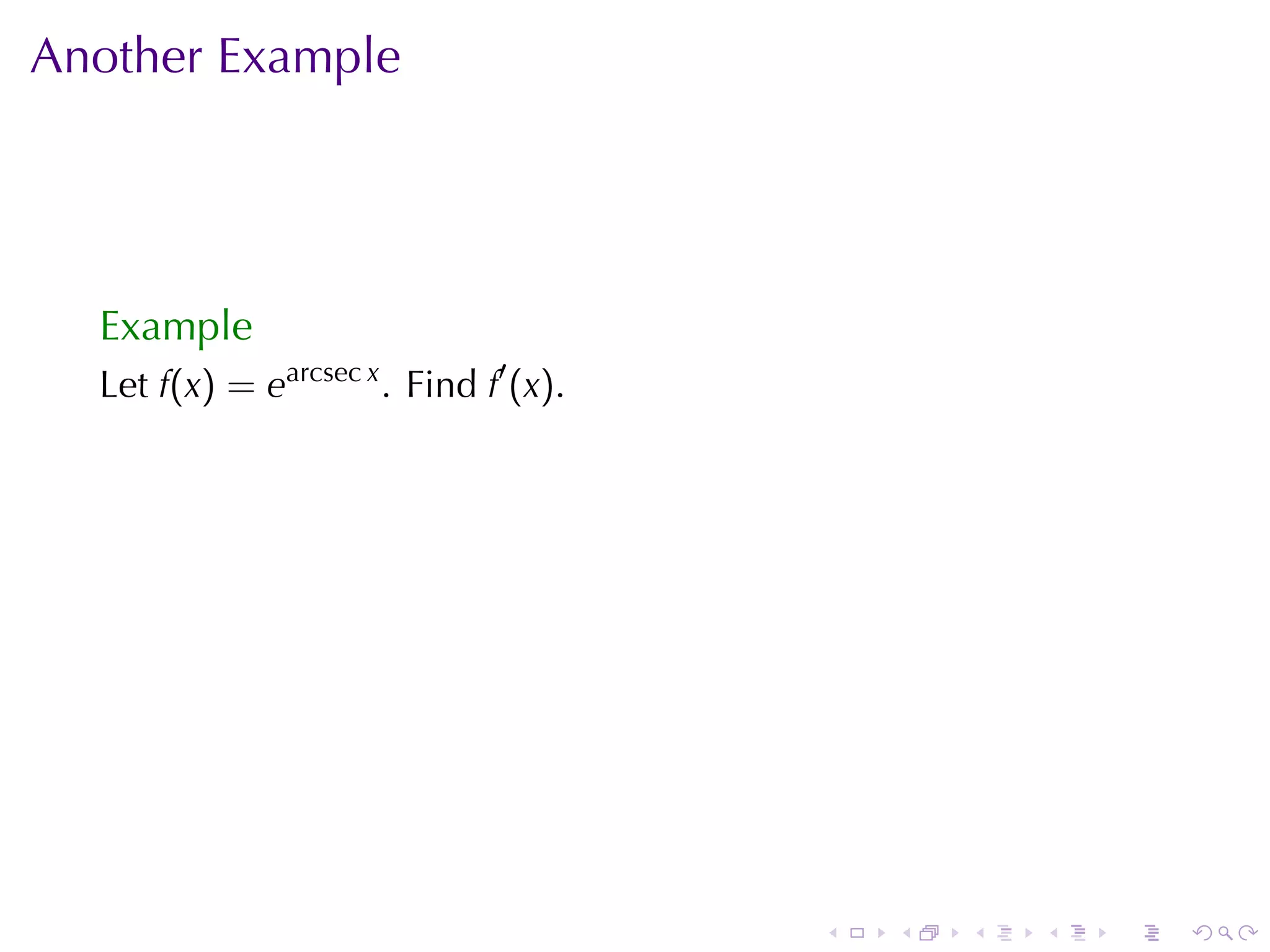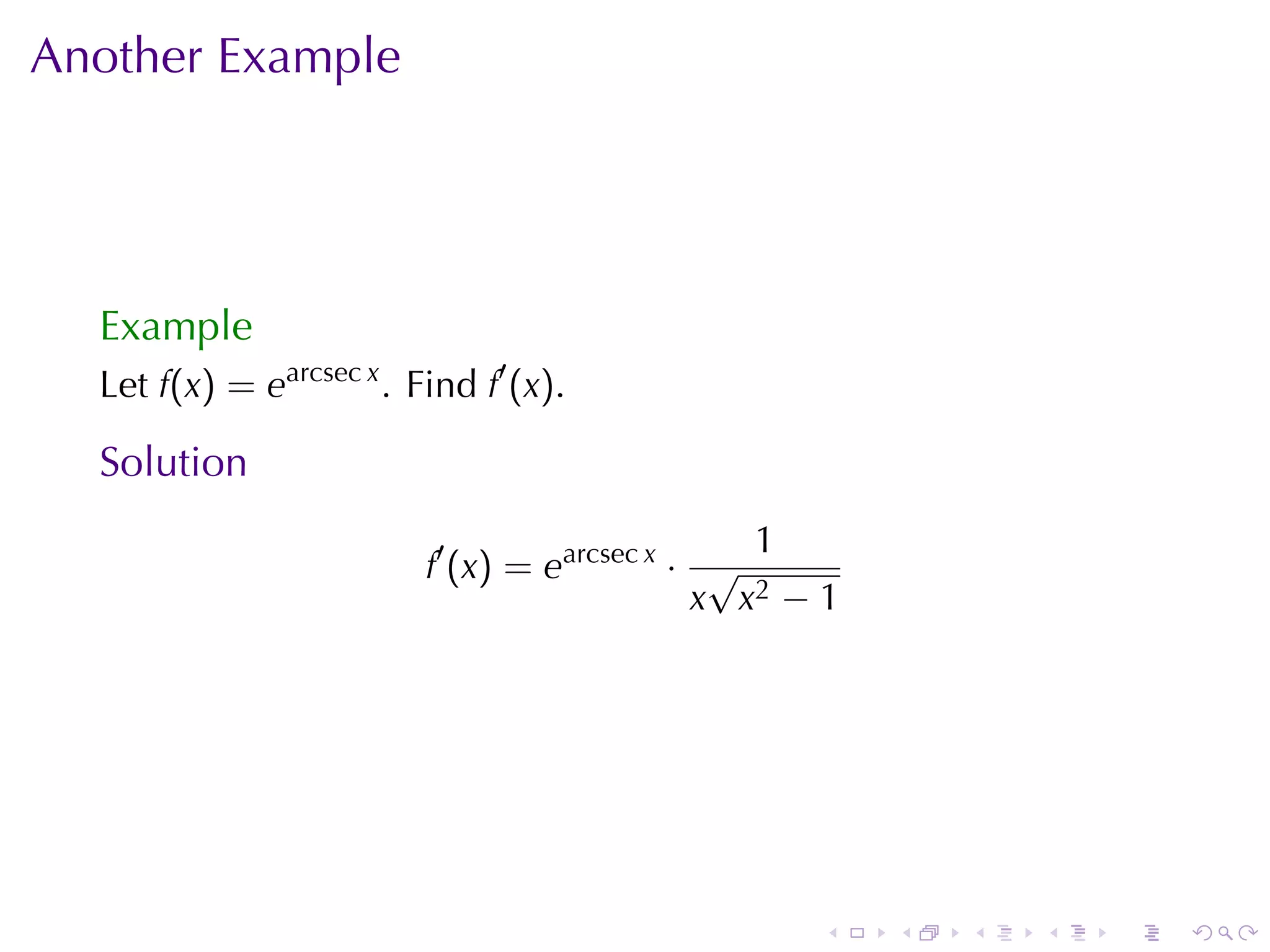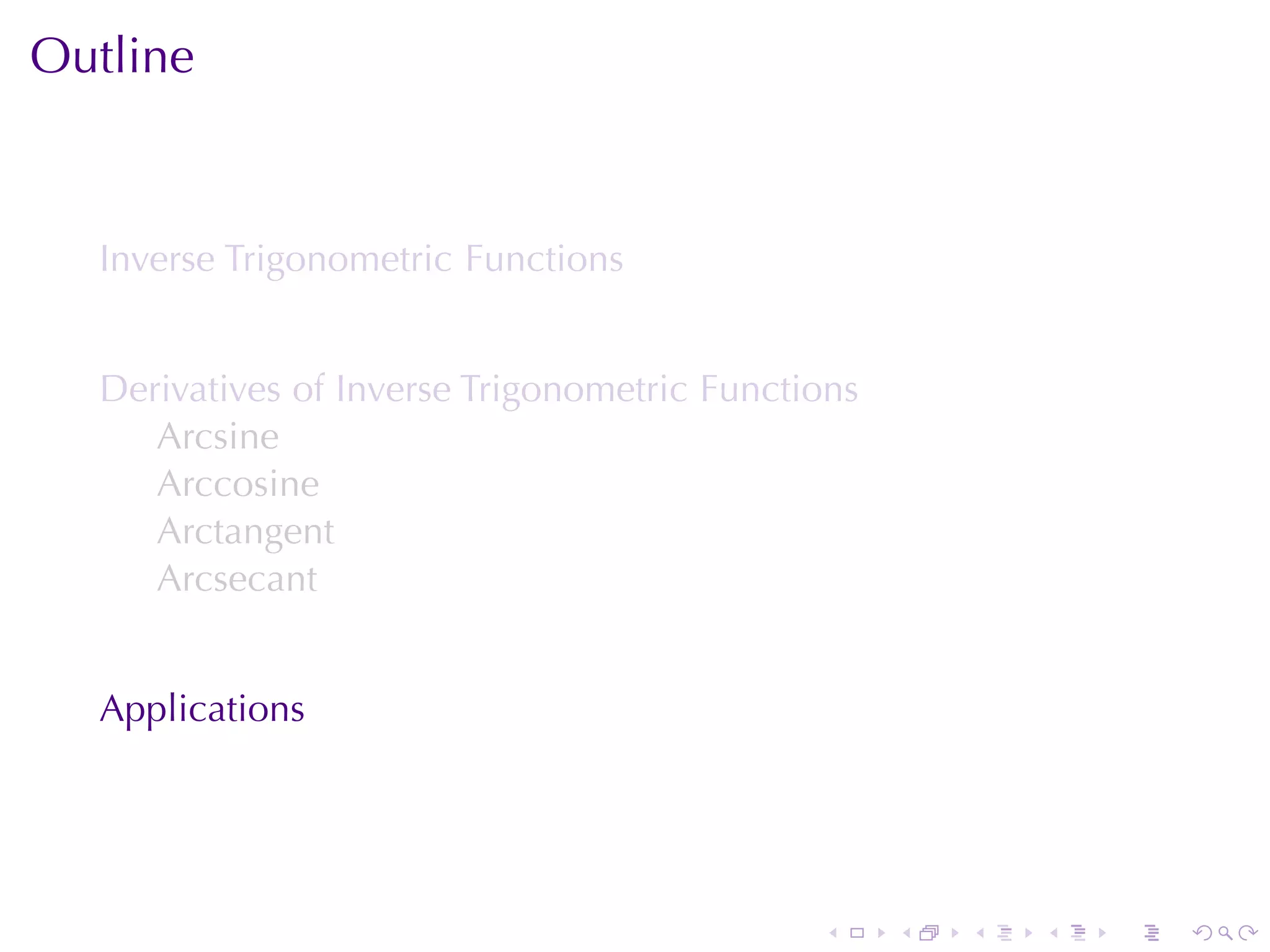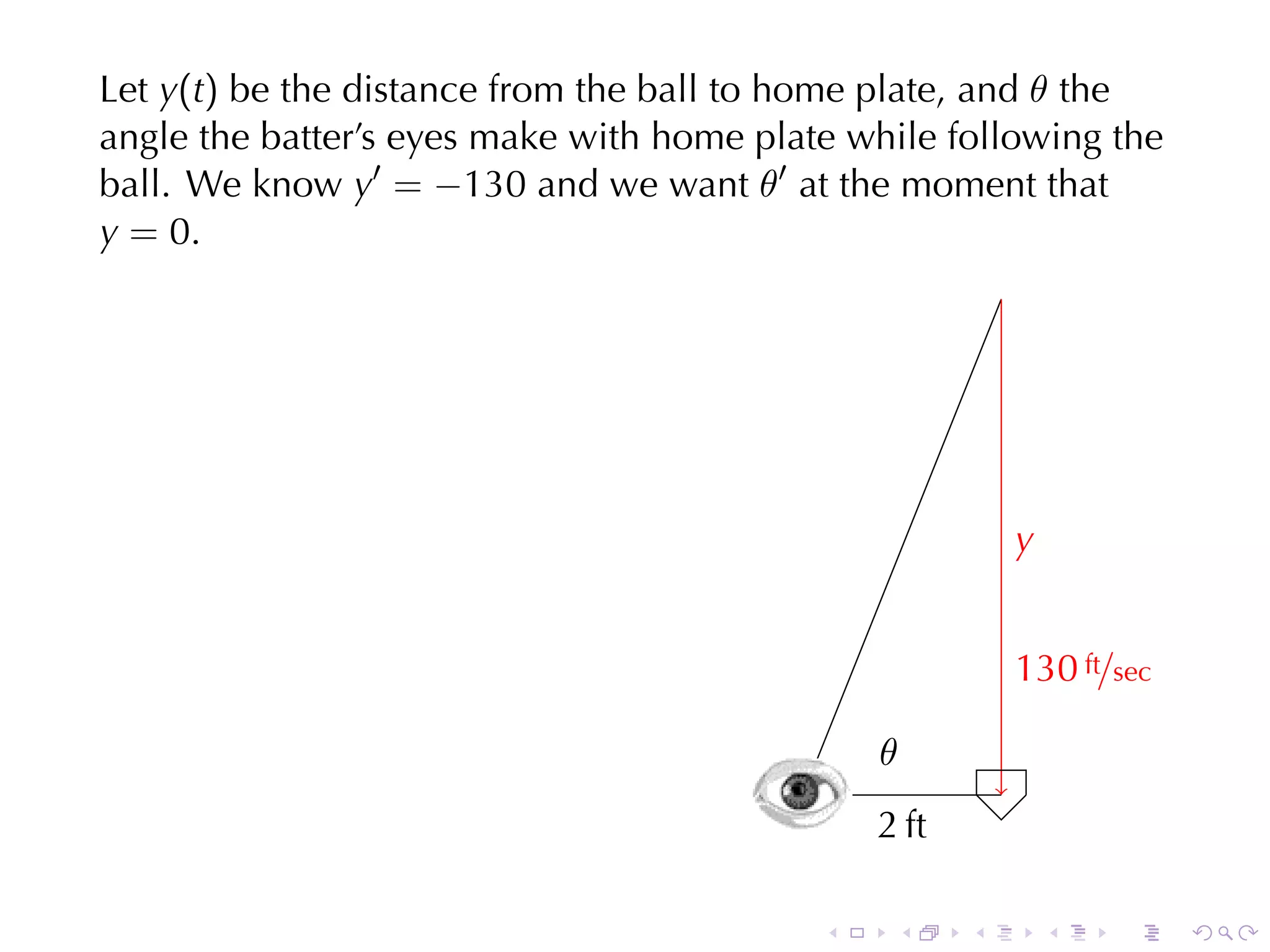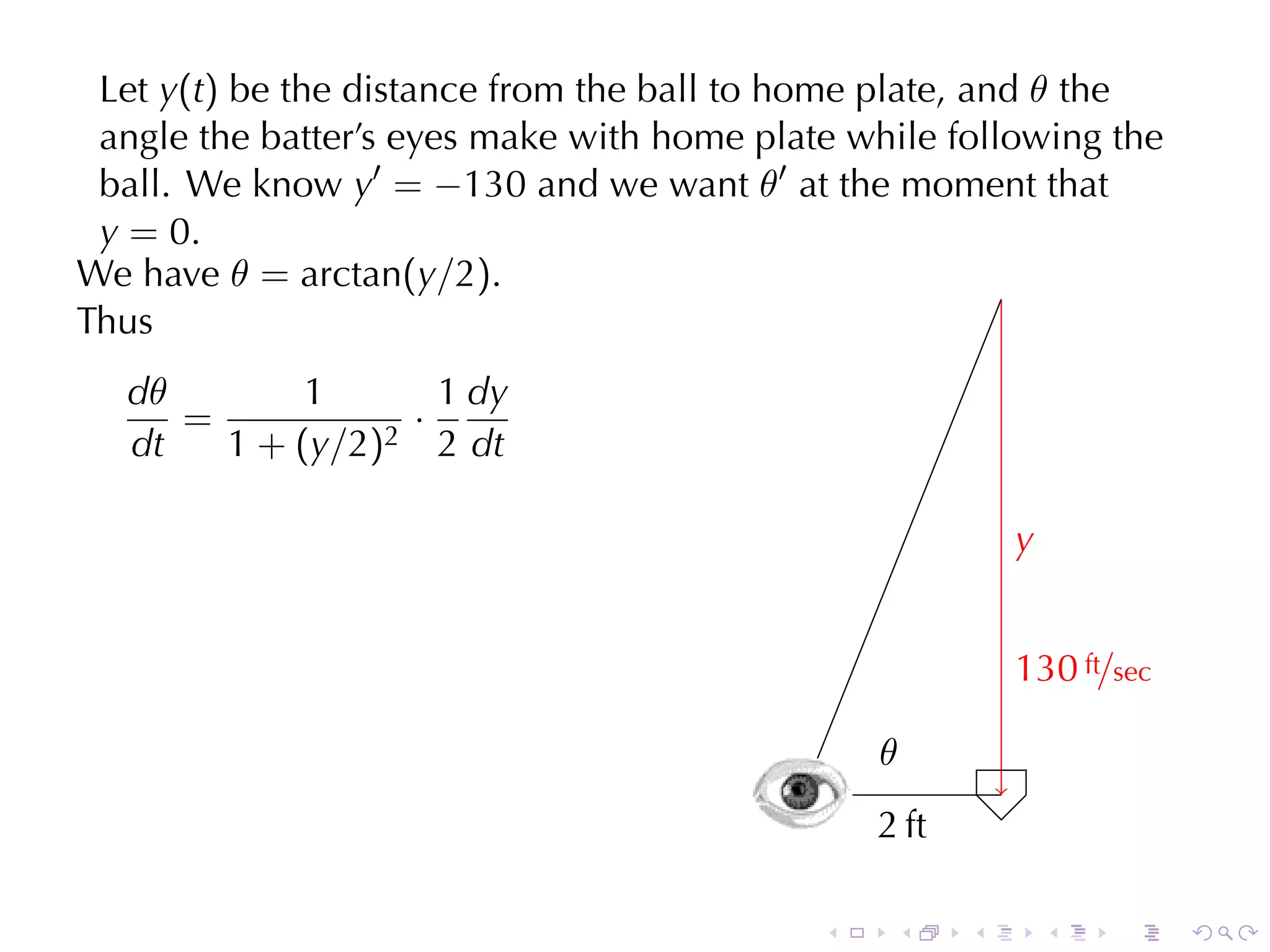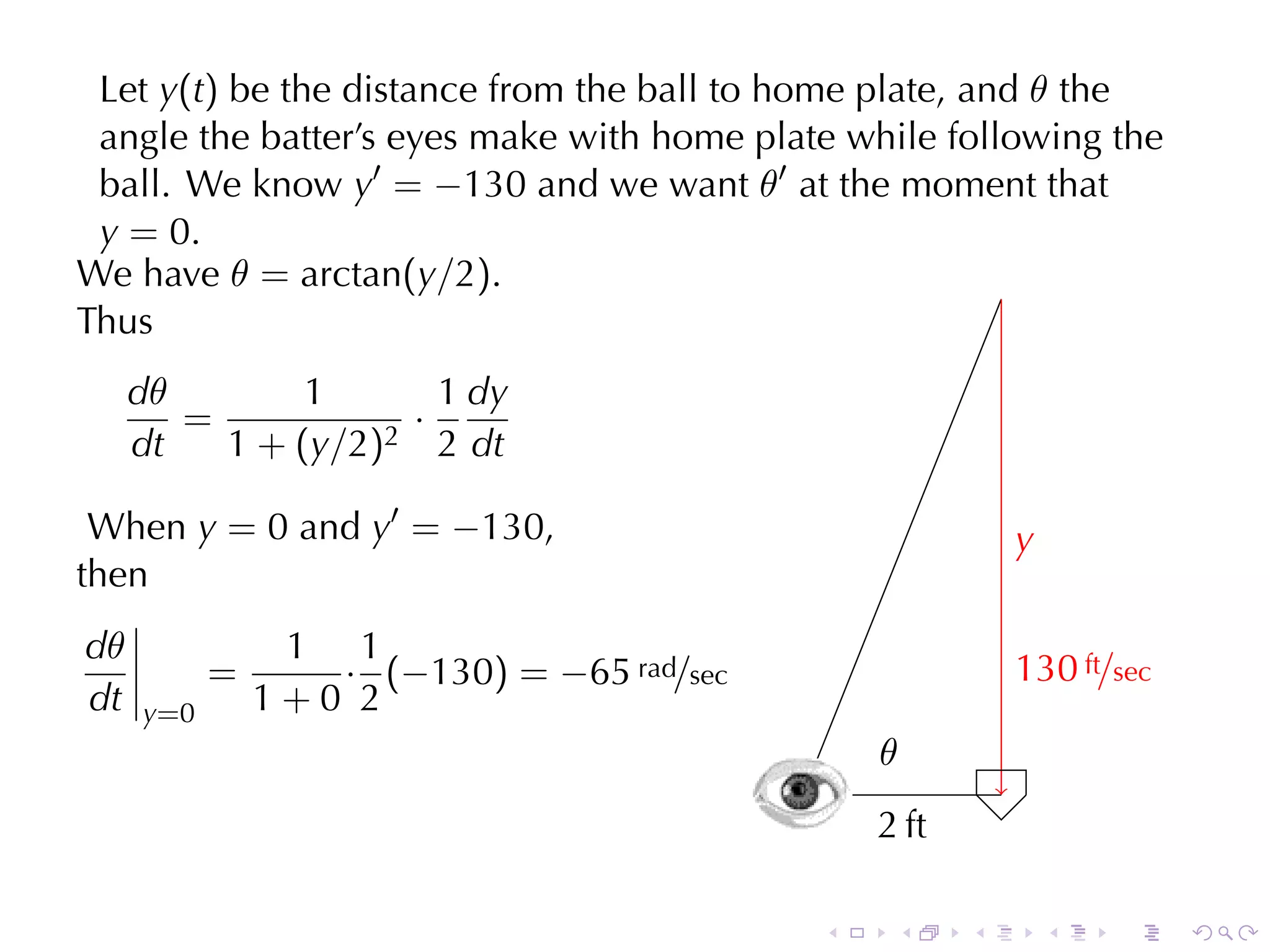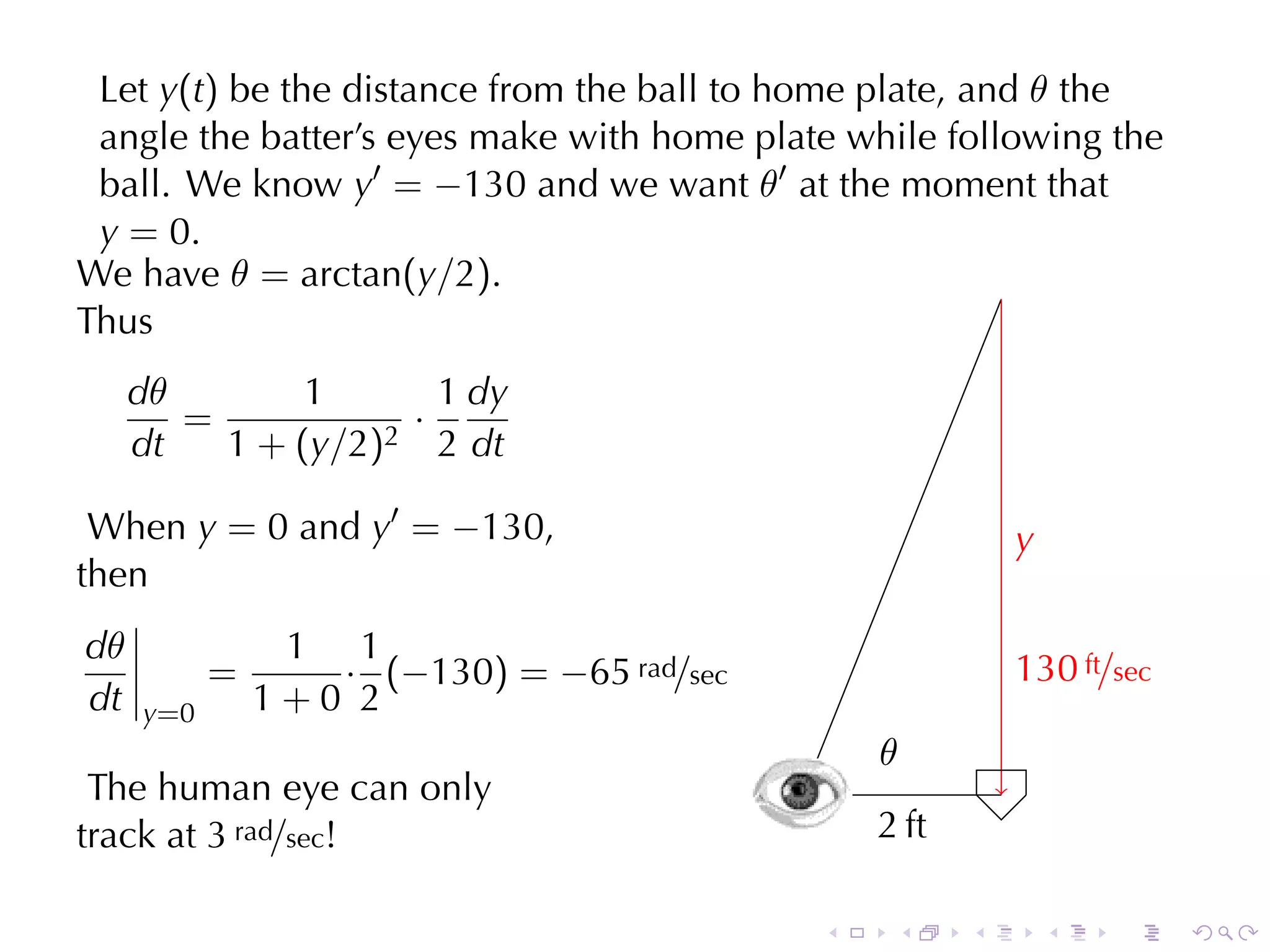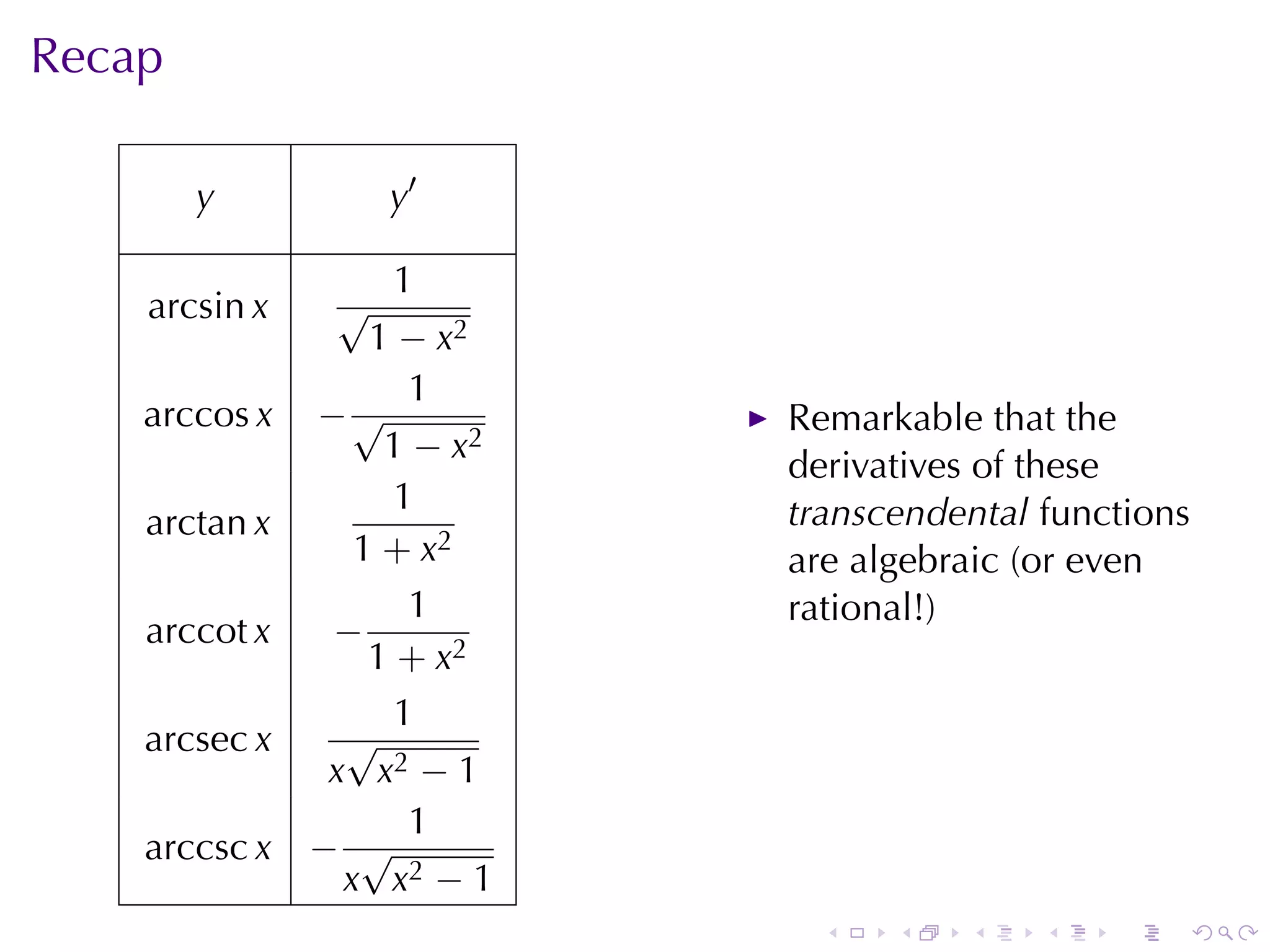This document contains lecture notes on inverse trigonometric functions. It begins with definitions of inverse functions and conditions for a function to have an inverse. It then defines the inverse trigonometric functions arcsin, arccos, arctan, and arcsec and gives their domains and ranges. Examples are provided to illustrate calculating values of the inverse trigonometric functions. The document concludes with a brief discussion of notational ambiguity and an outline mentioning that derivatives of the inverse trigonometric functions will be covered.
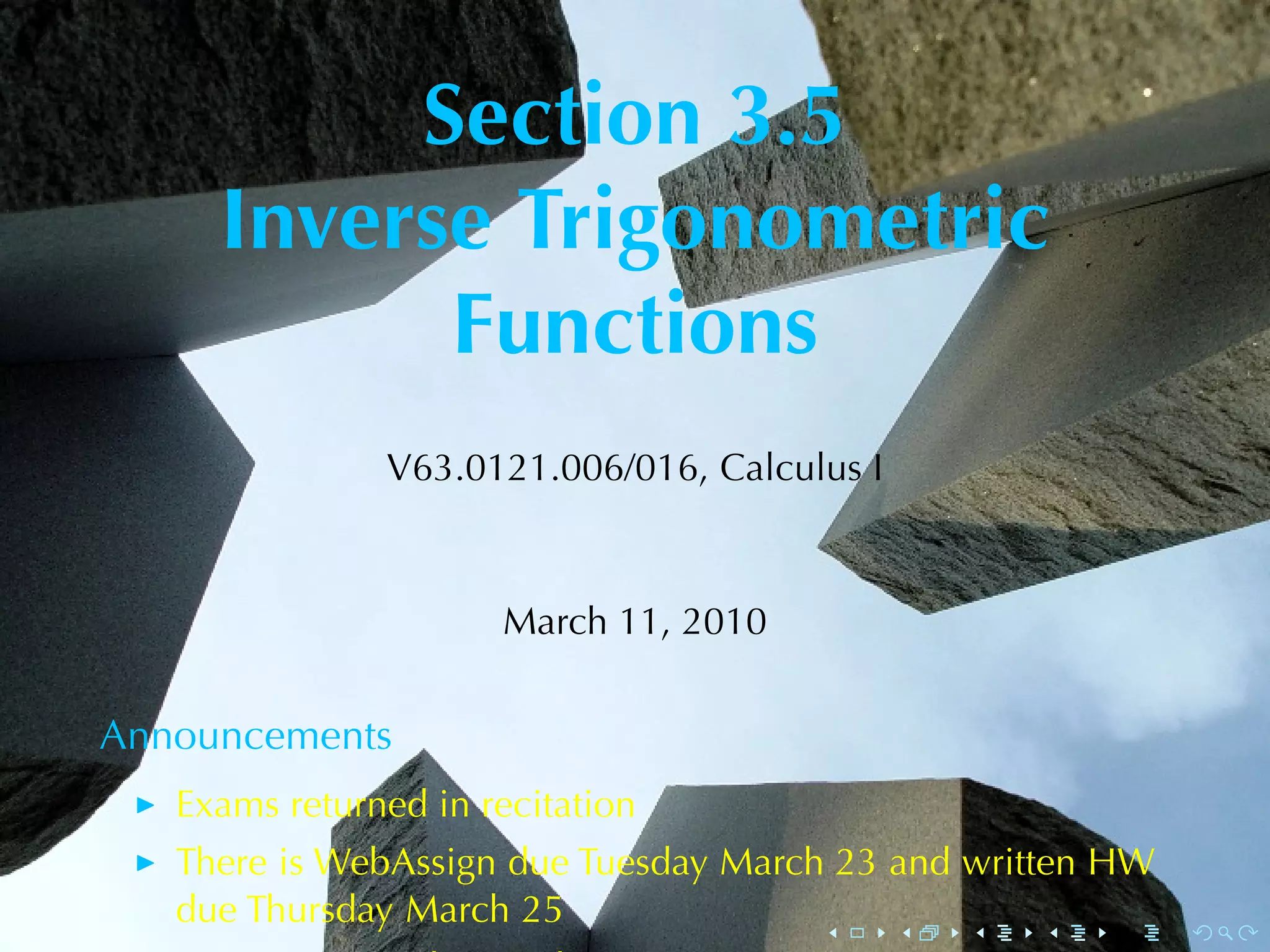

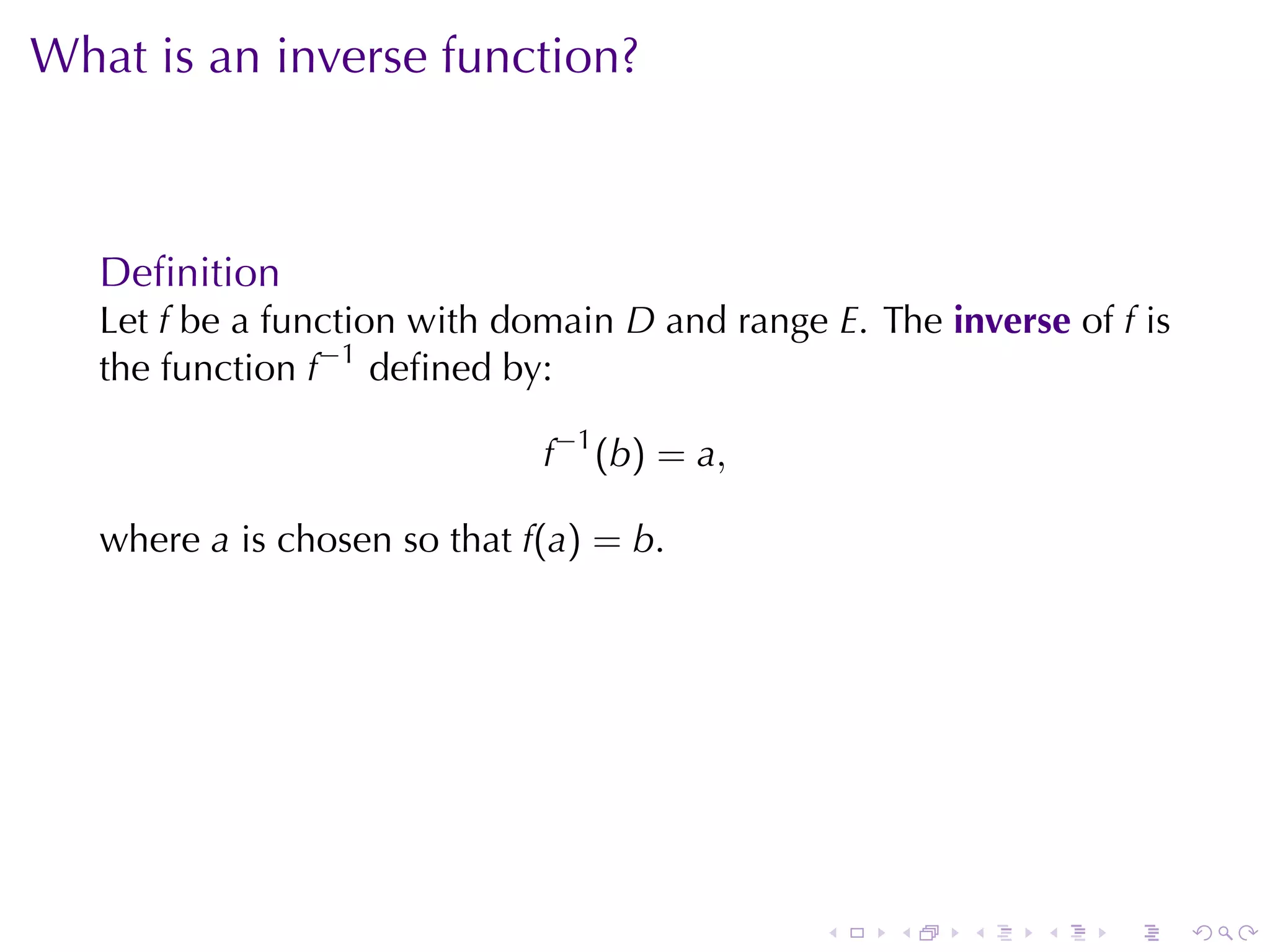
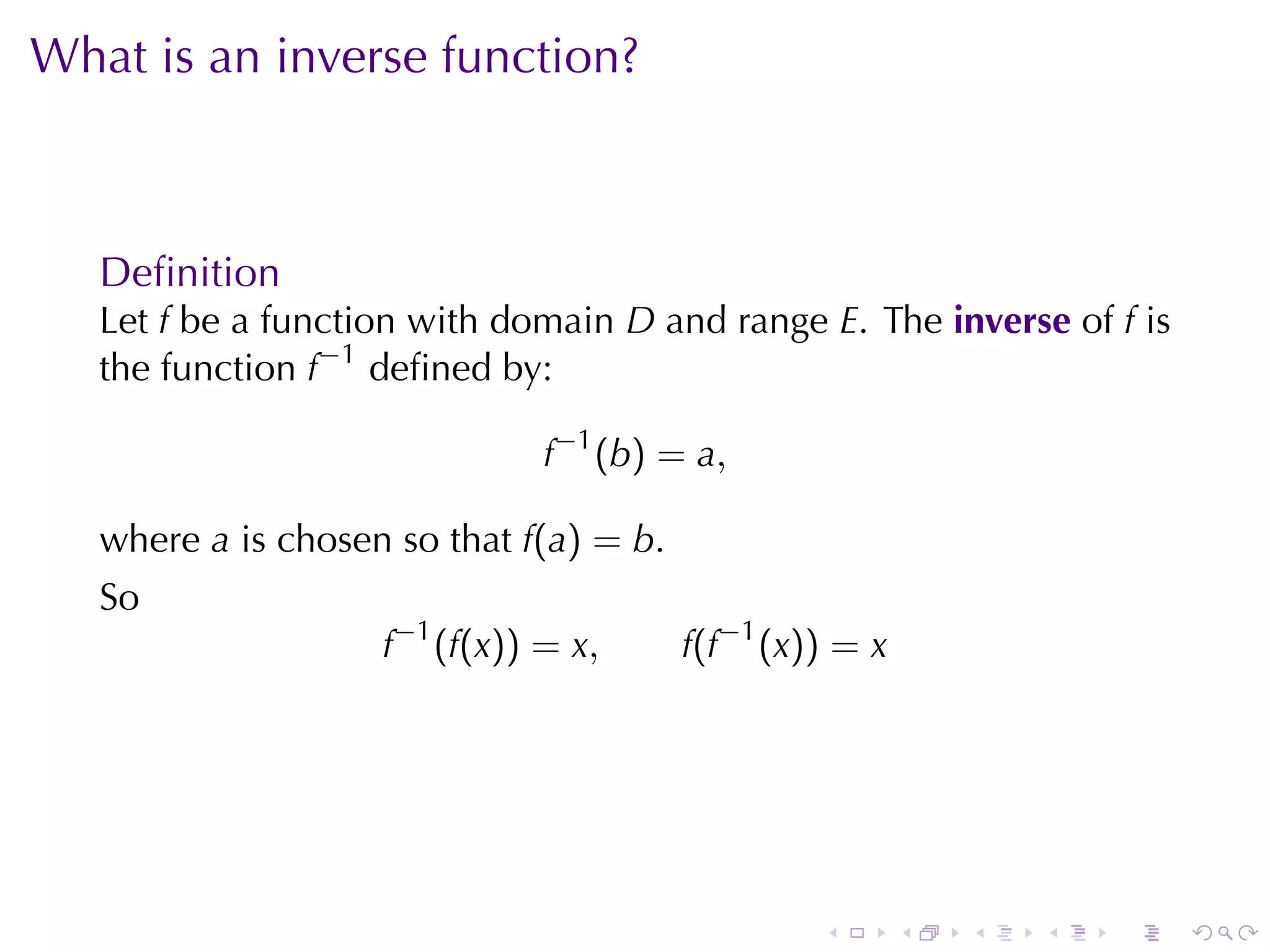
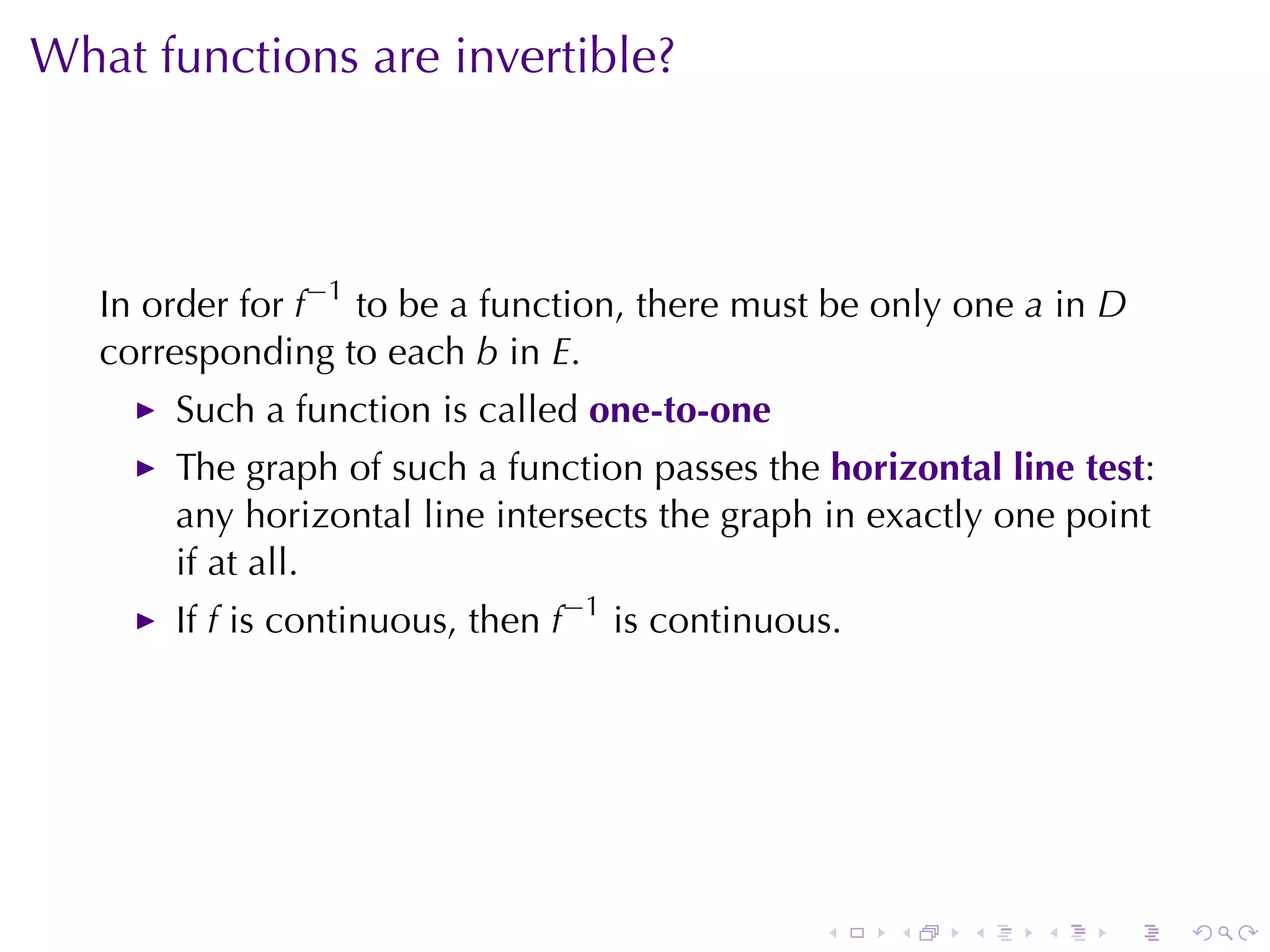
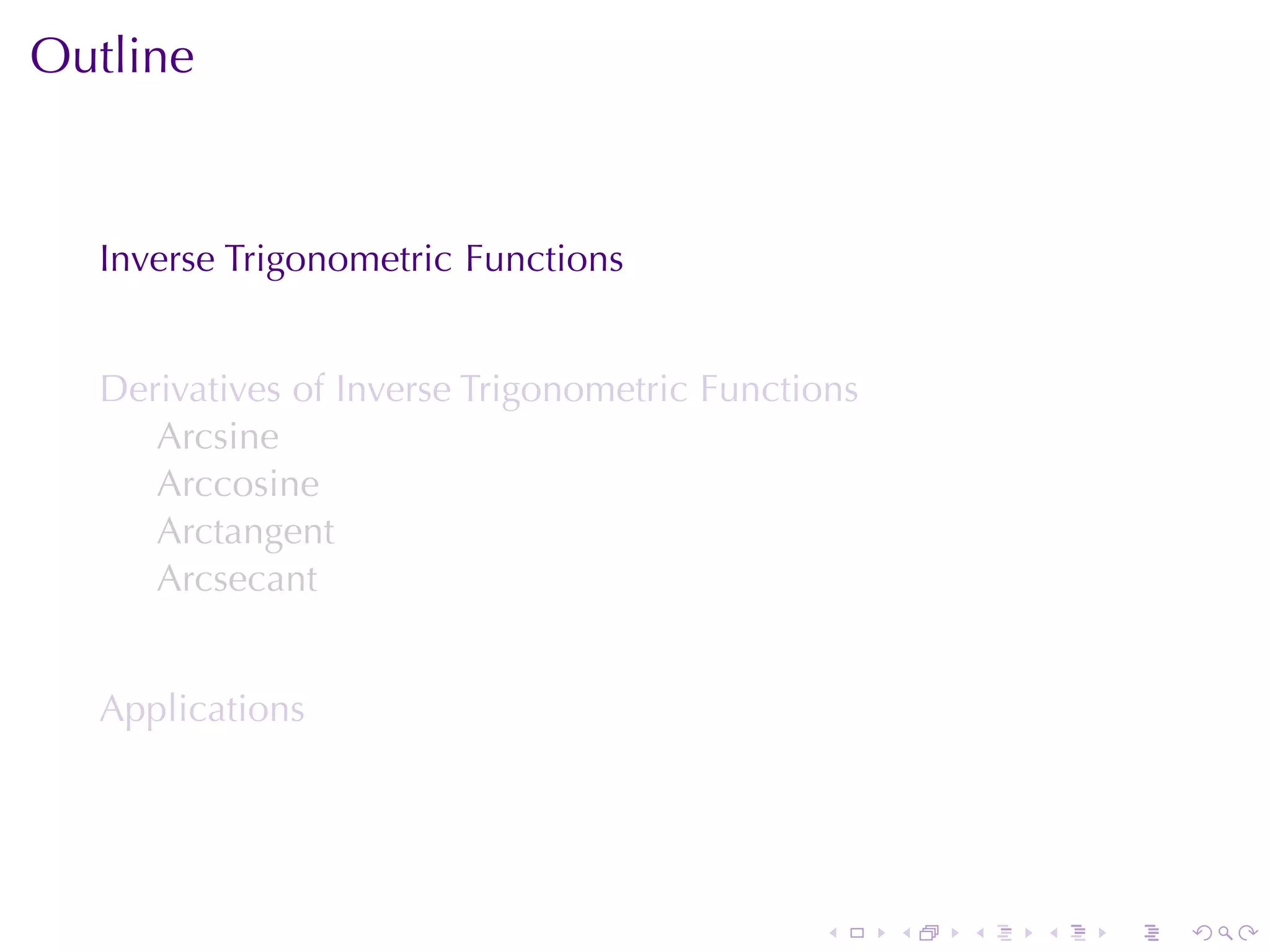
![arcsin
Arcsin is the inverse of the sine function after restriction to
[−π/2, π/2].
y
.
. . . x
.
π π s
. in
−
. .
2 2
. . . . . .](https://image.slidesharecdn.com/lesson15-inversetrigonometricfunctionsslides-100323145757-phpapp01/75/Lesson-15-Inverse-Trigonometric-Functions-7-2048.jpg)
![arcsin
Arcsin is the inverse of the sine function after restriction to
[−π/2, π/2].
y
.
.
. . . x
.
π π s
. in
−
. . .
2 2
. . . . . .](https://image.slidesharecdn.com/lesson15-inversetrigonometricfunctionsslides-100323145757-phpapp01/75/Lesson-15-Inverse-Trigonometric-Functions-8-2048.jpg)
![arcsin
Arcsin is the inverse of the sine function after restriction to
[−π/2, π/2].
y
.
y
. =x
.
. . . x
.
π π s
. in
−
. . .
2 2
. . . . . .](https://image.slidesharecdn.com/lesson15-inversetrigonometricfunctionsslides-100323145757-phpapp01/75/Lesson-15-Inverse-Trigonometric-Functions-9-2048.jpg)
![arcsin
Arcsin is the inverse of the sine function after restriction to
[−π/2, π/2].
y
.
. . rcsin
a
.
. . . x
.
π π s
. in
−
. . .
2 2
.
The domain of arcsin is [−1, 1]
[ π π]
The range of arcsin is − ,
2 2
. . . . . .](https://image.slidesharecdn.com/lesson15-inversetrigonometricfunctionsslides-100323145757-phpapp01/75/Lesson-15-Inverse-Trigonometric-Functions-10-2048.jpg)
![arccos
Arccos is the inverse of the cosine function after restriction to
[0, π]
y
.
c
. os
. . x
.
0
. .
π
. . . . . .](https://image.slidesharecdn.com/lesson15-inversetrigonometricfunctionsslides-100323145757-phpapp01/75/Lesson-15-Inverse-Trigonometric-Functions-11-2048.jpg)
![arccos
Arccos is the inverse of the cosine function after restriction to
[0, π]
y
.
.
c
. os
. . x
.
0
. .
π
.
. . . . . .](https://image.slidesharecdn.com/lesson15-inversetrigonometricfunctionsslides-100323145757-phpapp01/75/Lesson-15-Inverse-Trigonometric-Functions-12-2048.jpg)
![arccos
Arccos is the inverse of the cosine function after restriction to
[0, π]
y
.
y
. =x
.
c
. os
. . x
.
0
. .
π
.
. . . . . .](https://image.slidesharecdn.com/lesson15-inversetrigonometricfunctionsslides-100323145757-phpapp01/75/Lesson-15-Inverse-Trigonometric-Functions-13-2048.jpg)
![arccos
Arccos is the inverse of the cosine function after restriction to
[0, π]
. . rccos
a
y
.
.
c
. os
. . . x
.
0
. .
π
.
The domain of arccos is [−1, 1]
The range of arccos is [0, π]
. . . . . .](https://image.slidesharecdn.com/lesson15-inversetrigonometricfunctionsslides-100323145757-phpapp01/75/Lesson-15-Inverse-Trigonometric-Functions-14-2048.jpg)
![arctan
Arctan is the inverse of the tangent function after restriction to
[−π/2, π/2].
y
.
. x
.
3π π π 3π
−
. −
. . .
2 2 2 2
t
.an
. . . . . .](https://image.slidesharecdn.com/lesson15-inversetrigonometricfunctionsslides-100323145757-phpapp01/75/Lesson-15-Inverse-Trigonometric-Functions-15-2048.jpg)
![arctan
Arctan is the inverse of the tangent function after restriction to
[−π/2, π/2].
y
.
. x
.
3π π π 3π
−
. −
. . .
2 2 2 2
t
.an
. . . . . .](https://image.slidesharecdn.com/lesson15-inversetrigonometricfunctionsslides-100323145757-phpapp01/75/Lesson-15-Inverse-Trigonometric-Functions-16-2048.jpg)
![arctan
Arctan is the inverse of the tangent function after restriction to
y
. =x
[−π/2, π/2].
y
.
. x
.
3π π π 3π
−
. −
. . .
2 2 2 2
t
.an
. . . . . .](https://image.slidesharecdn.com/lesson15-inversetrigonometricfunctionsslides-100323145757-phpapp01/75/Lesson-15-Inverse-Trigonometric-Functions-17-2048.jpg)
![arctan
Arctan is the inverse of the tangent function after restriction to
[−π/2, π/2].
y
.
π
. a
. rctan
2
. x
.
π
−
.
2
The domain of arctan is (−∞, ∞)
( π π)
The range of arctan is − ,
2 2
π π
lim arctan x = , lim arctan x = −
x→∞ 2 x→−∞ 2
. . . . . .](https://image.slidesharecdn.com/lesson15-inversetrigonometricfunctionsslides-100323145757-phpapp01/75/Lesson-15-Inverse-Trigonometric-Functions-18-2048.jpg)
![arcsec
Arcsecant is the inverse of secant after restriction to
[0, π/2) ∪ (π, 3π/2].
y
.
. x
.
3π π π 3π
−
. −
. . .
2 2 2 2
s
. ec
. . . . . .](https://image.slidesharecdn.com/lesson15-inversetrigonometricfunctionsslides-100323145757-phpapp01/75/Lesson-15-Inverse-Trigonometric-Functions-19-2048.jpg)
![arcsec
Arcsecant is the inverse of secant after restriction to
[0, π/2) ∪ (π, 3π/2].
y
.
.
. x
.
3π π π 3π
−
. −
. . . .
2 2 2 2
s
. ec
. . . . . .](https://image.slidesharecdn.com/lesson15-inversetrigonometricfunctionsslides-100323145757-phpapp01/75/Lesson-15-Inverse-Trigonometric-Functions-20-2048.jpg)
![arcsec
Arcsecant is the inverse of secant after restriction to
y
. =x
[0, π/2) ∪ (π, 3π/2].
y
.
.
. x
.
3π π π 3π
−
. −
. . . .
2 2 2 2
s
. ec
. . . . . .](https://image.slidesharecdn.com/lesson15-inversetrigonometricfunctionsslides-100323145757-phpapp01/75/Lesson-15-Inverse-Trigonometric-Functions-21-2048.jpg)
![arcsec 3π
.
Arcsecant is the inverse of secant after restriction to
2
[0, π/2) ∪ (π, 3π/2].
. . y
π
.
2 .
. . x
.
.
The domain of arcsec is (−∞, −1] ∪ [1, ∞)
[ π ) (π ]
The range of arcsec is 0, ∪ ,π
2 2
π 3π
lim arcsec x = , lim arcsec x =
x→∞ 2 x→−∞ 2
. . . . . .](https://image.slidesharecdn.com/lesson15-inversetrigonometricfunctionsslides-100323145757-phpapp01/75/Lesson-15-Inverse-Trigonometric-Functions-22-2048.jpg)
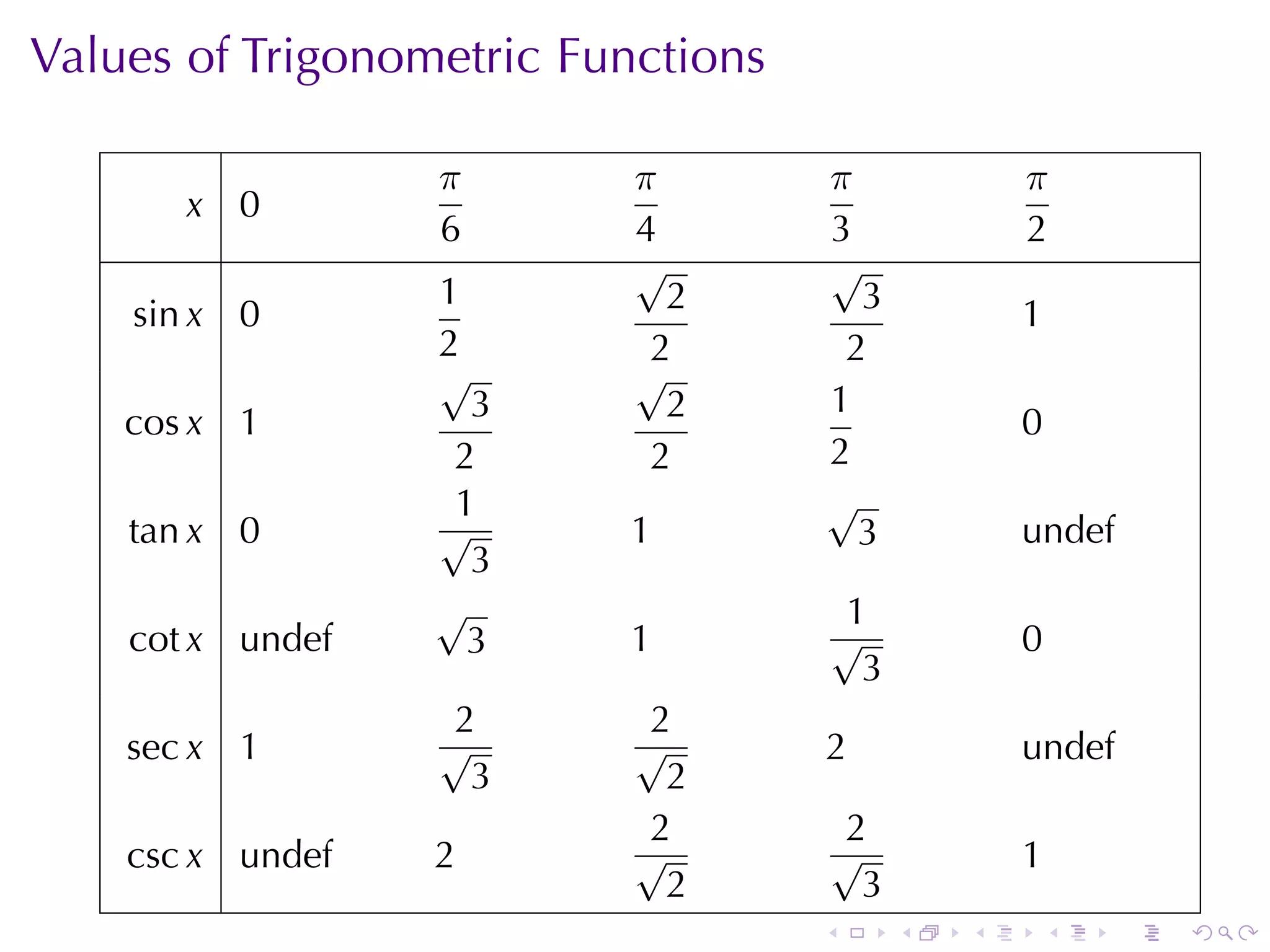
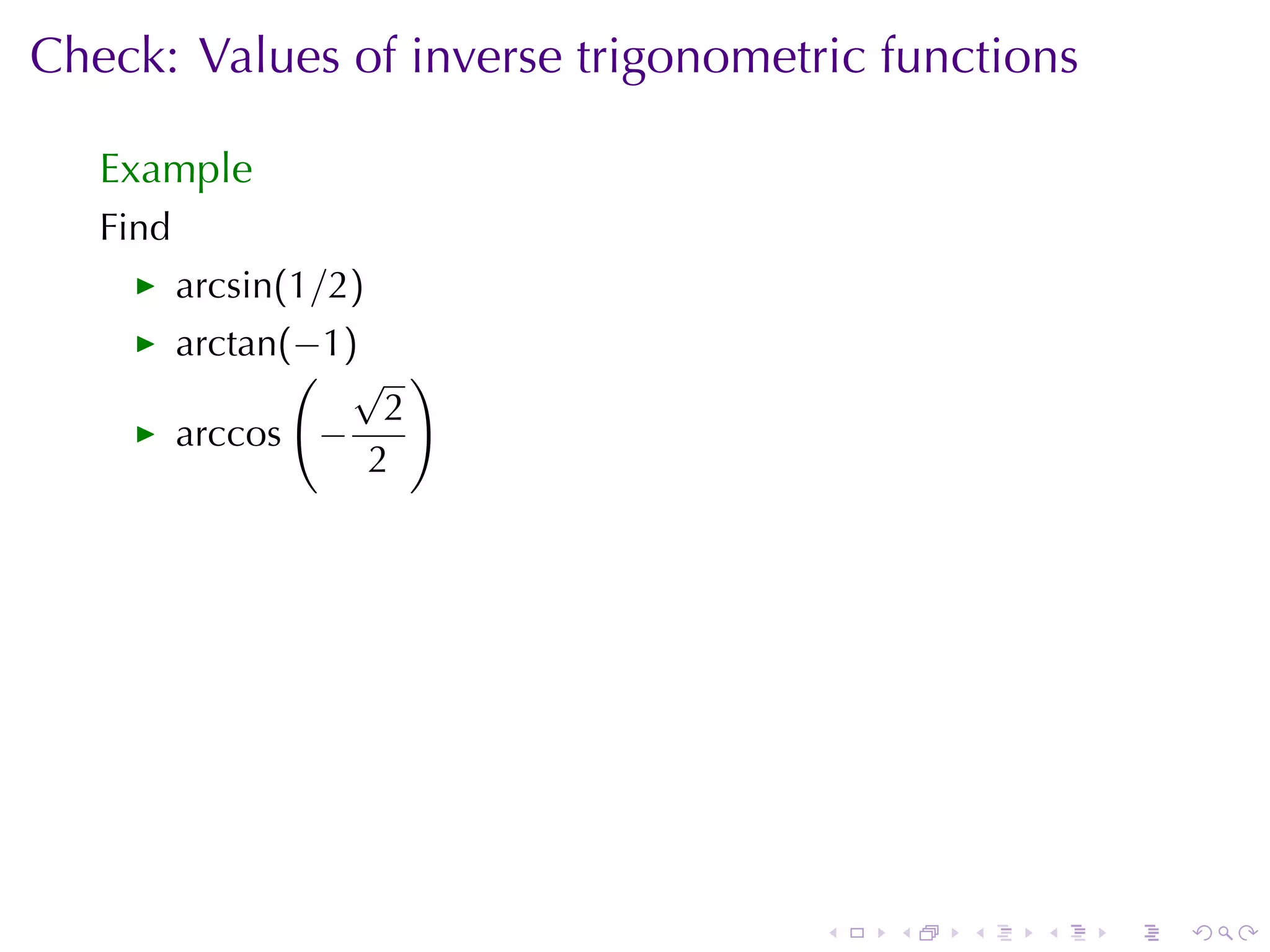
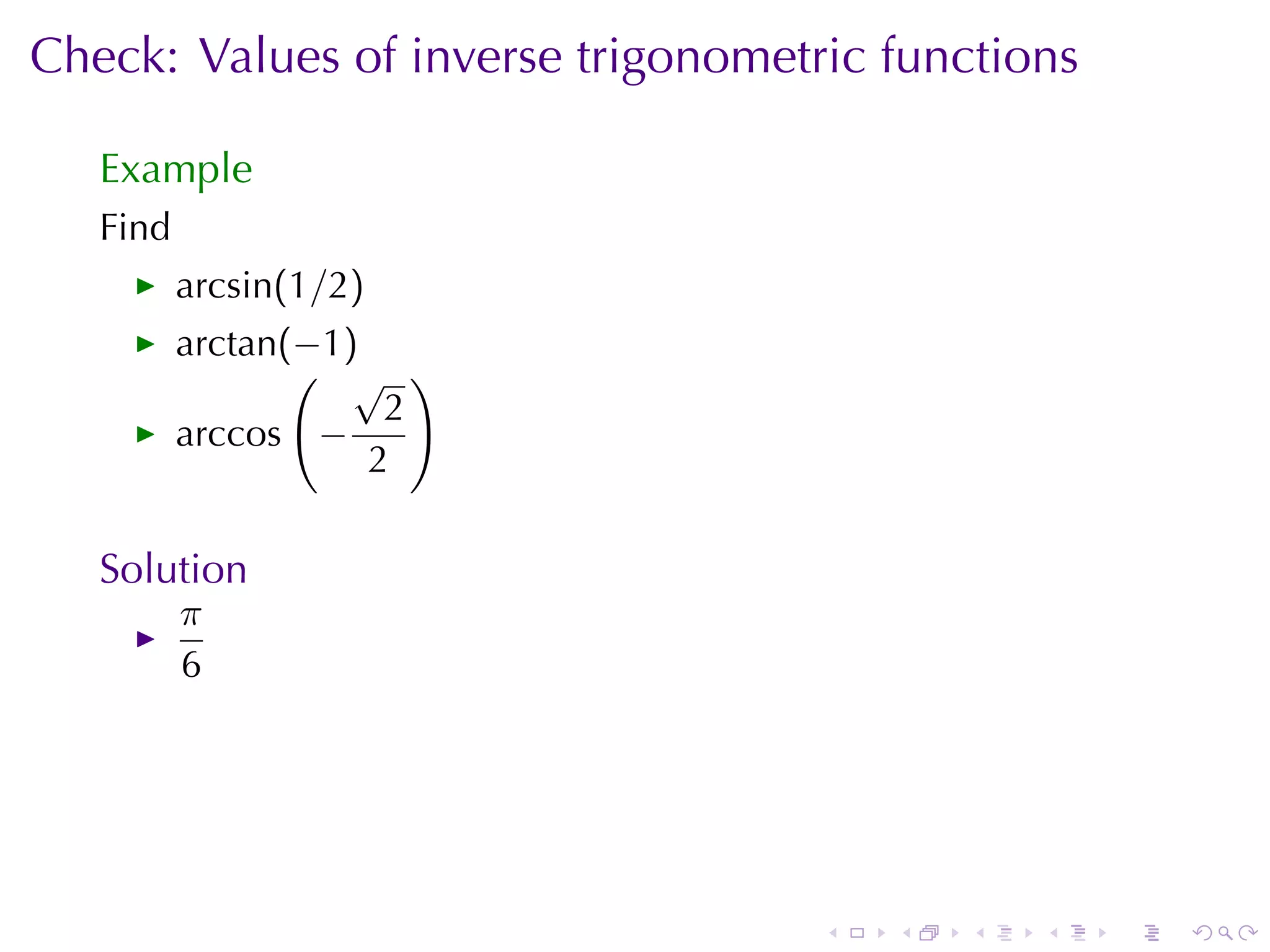

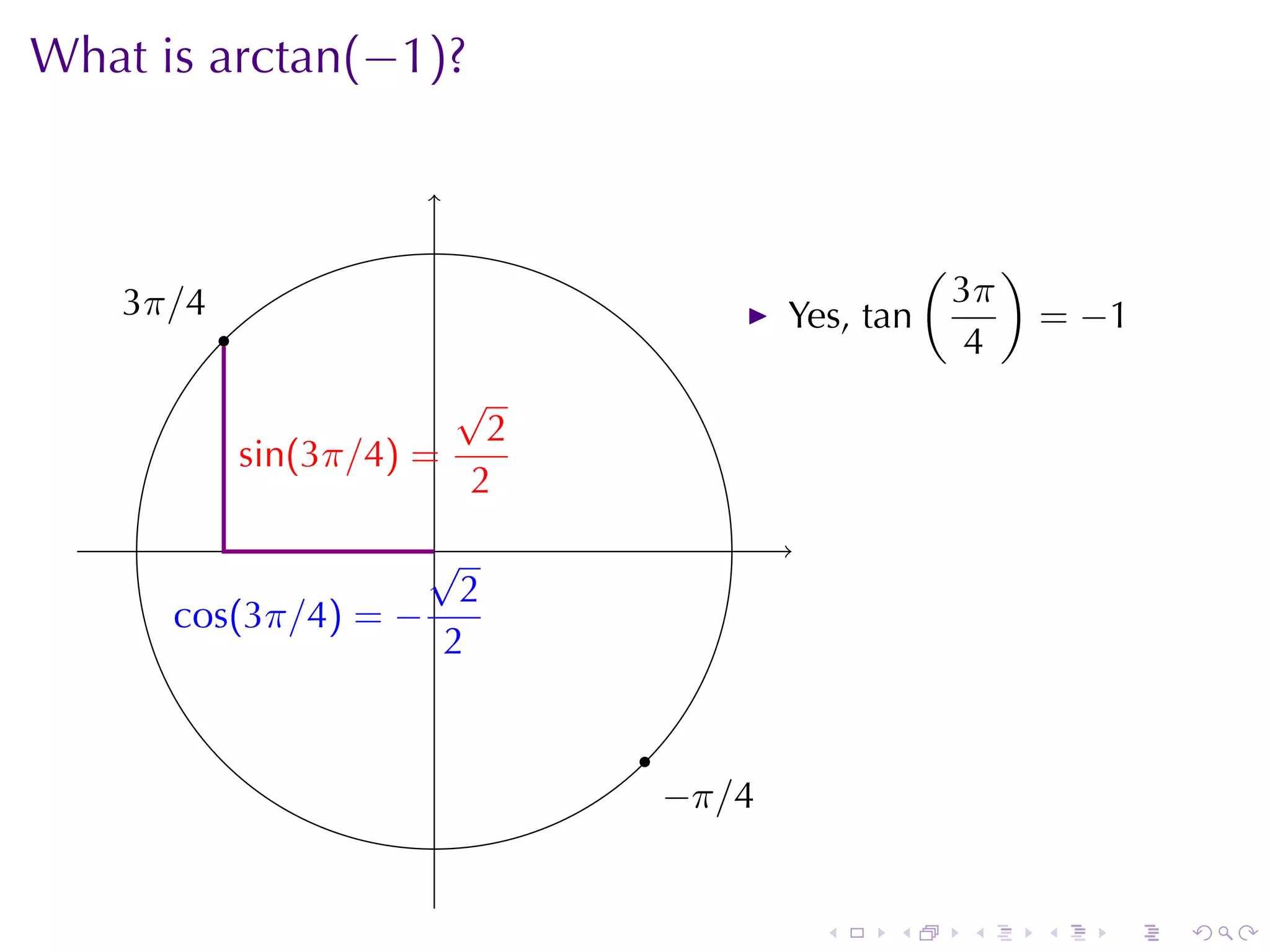
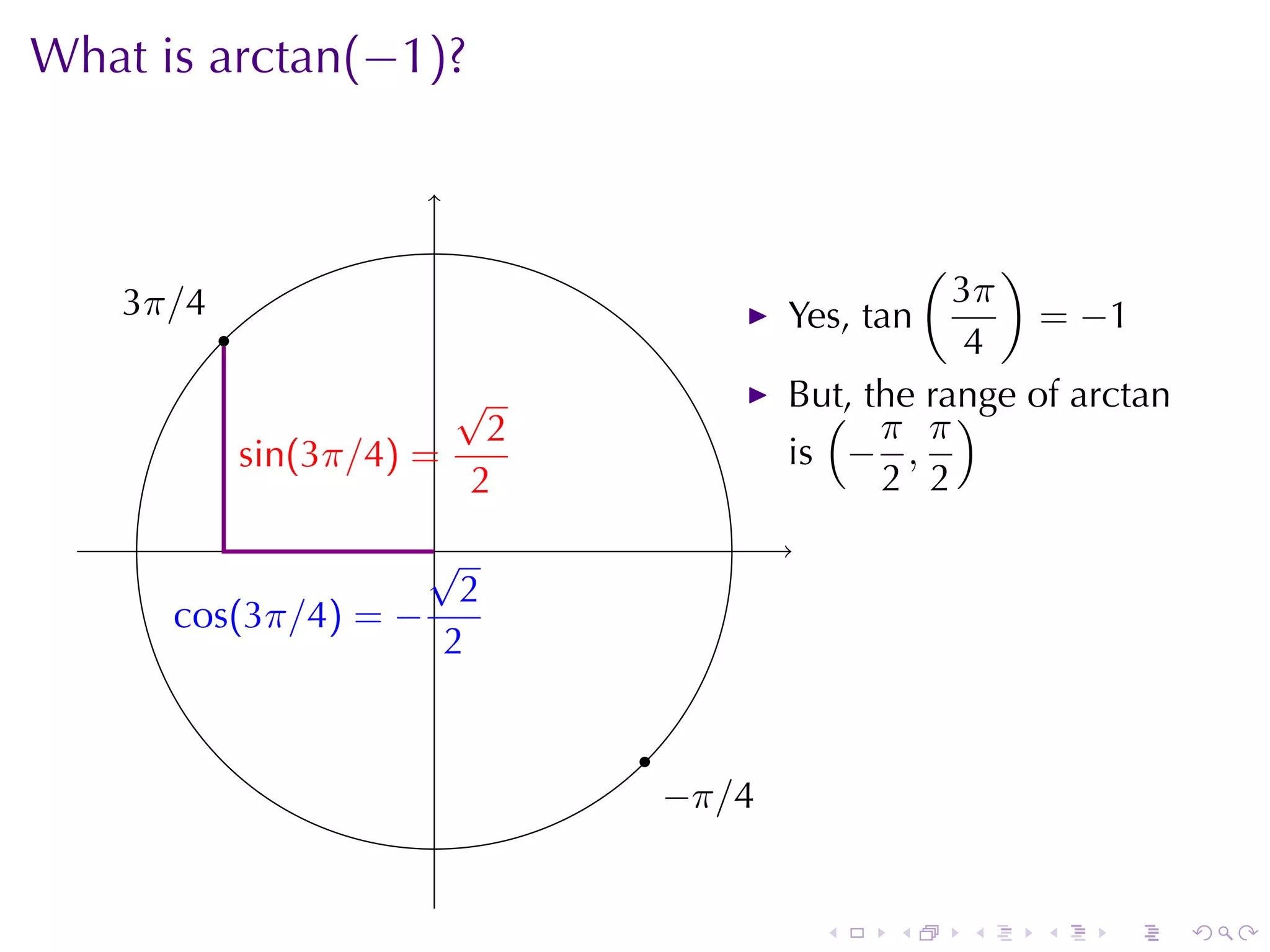
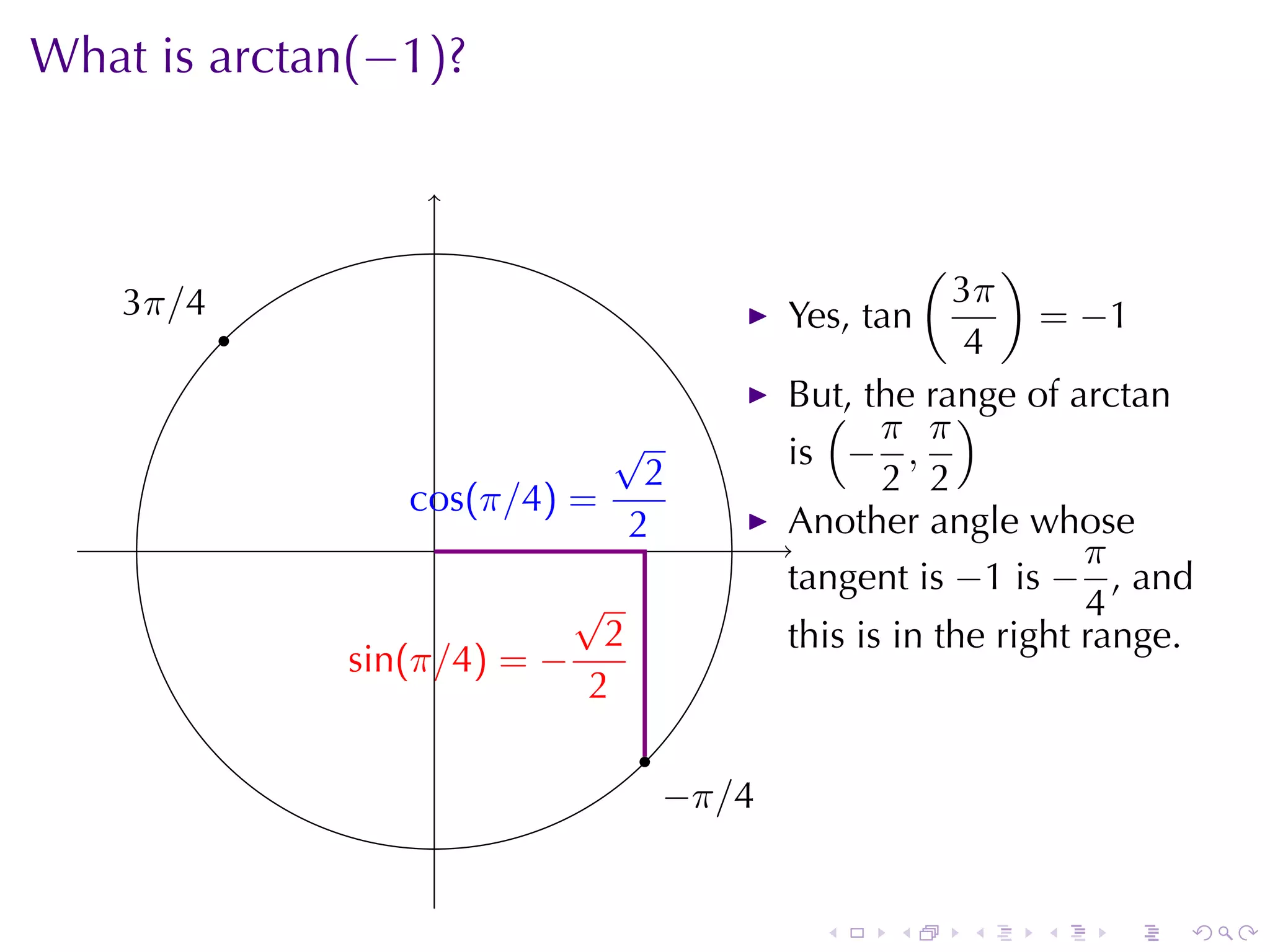
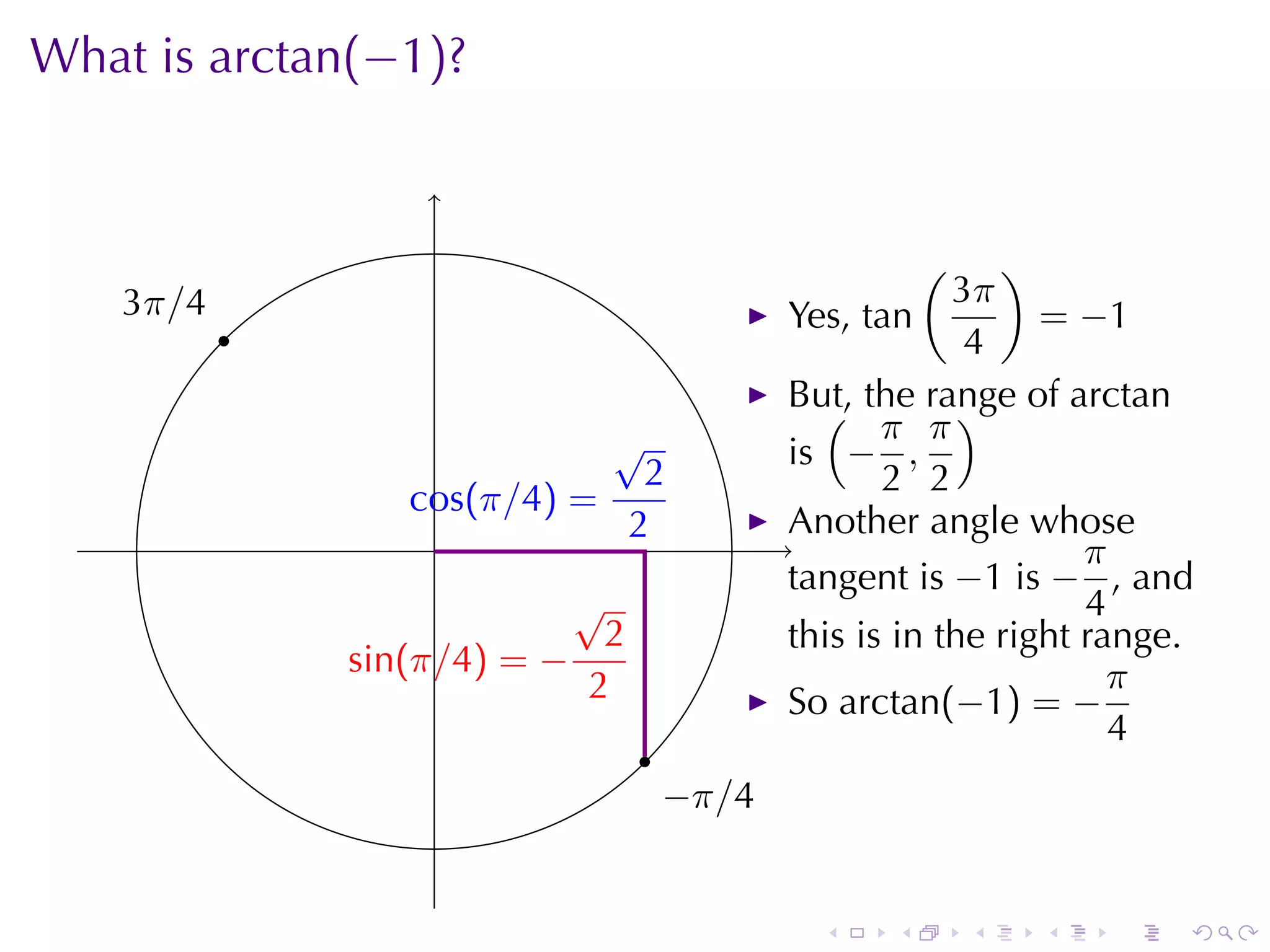
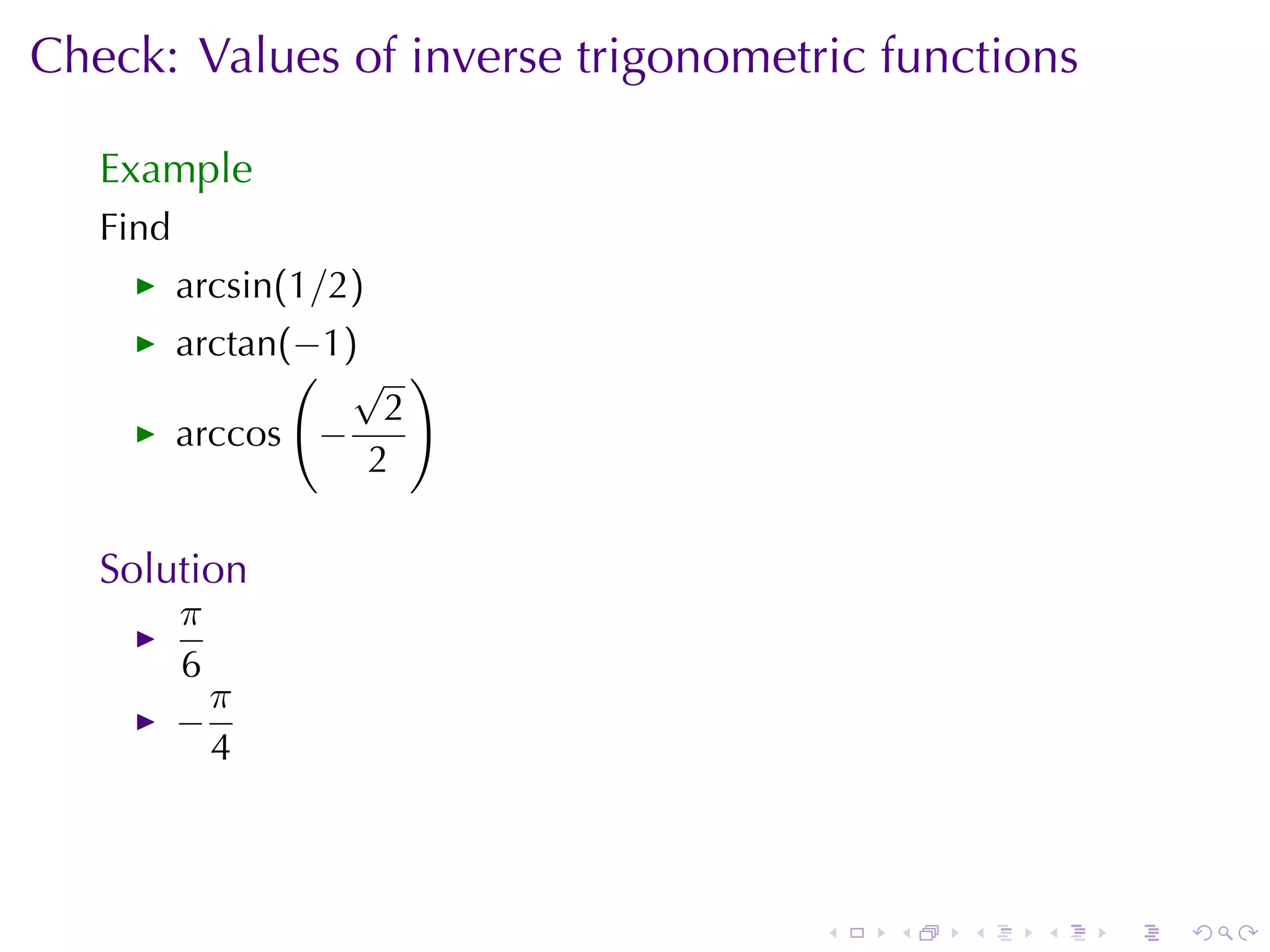
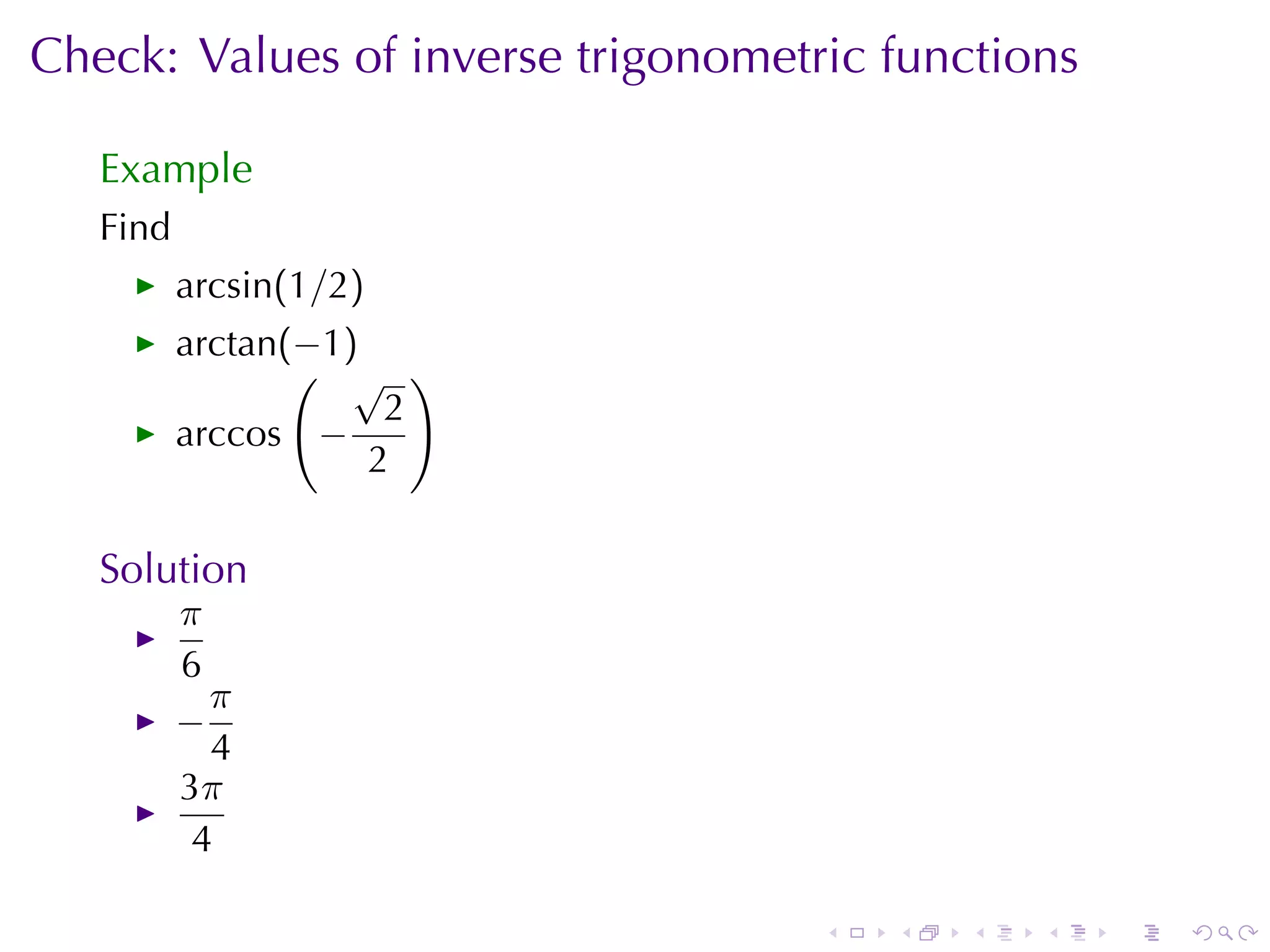
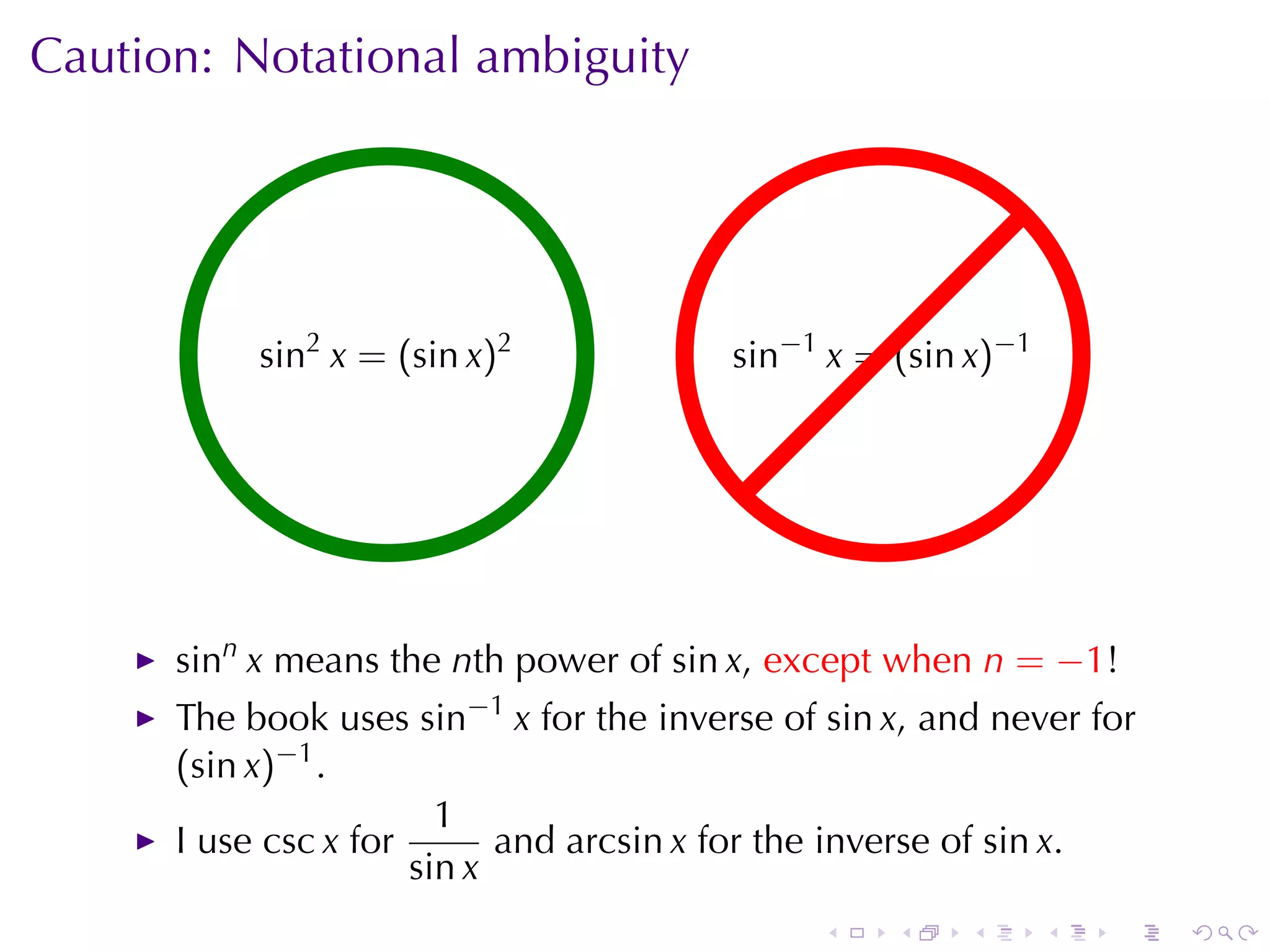
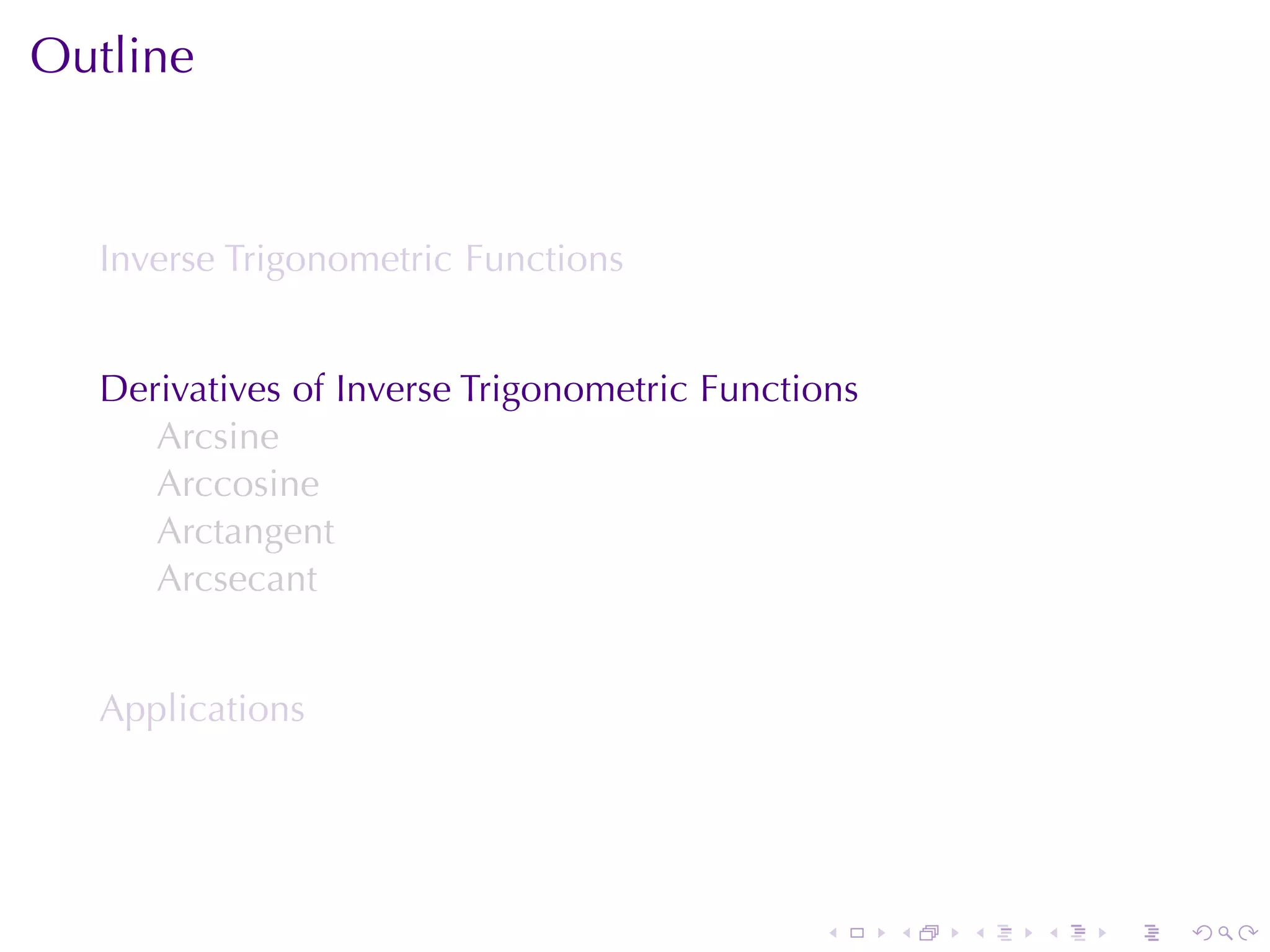
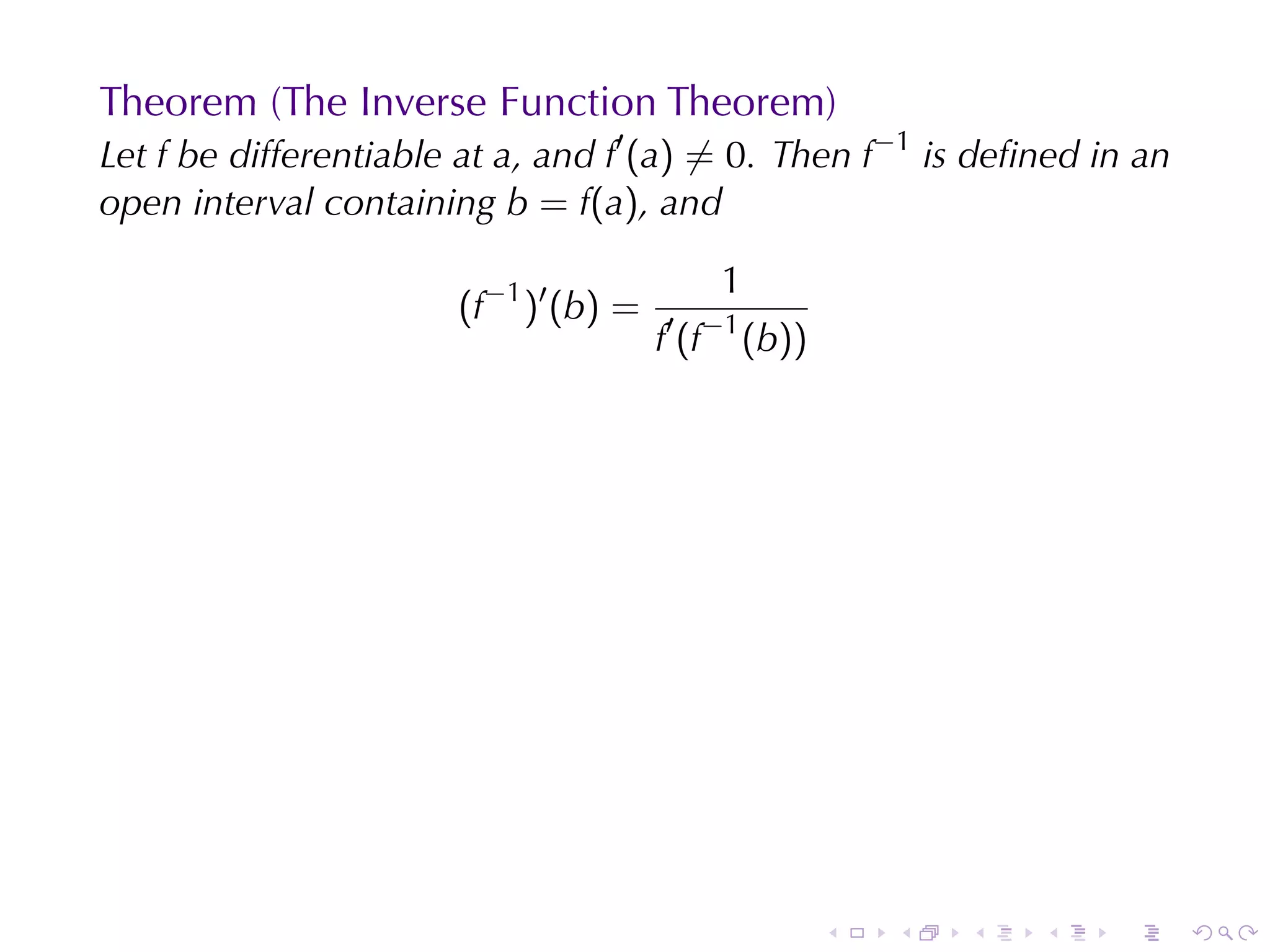
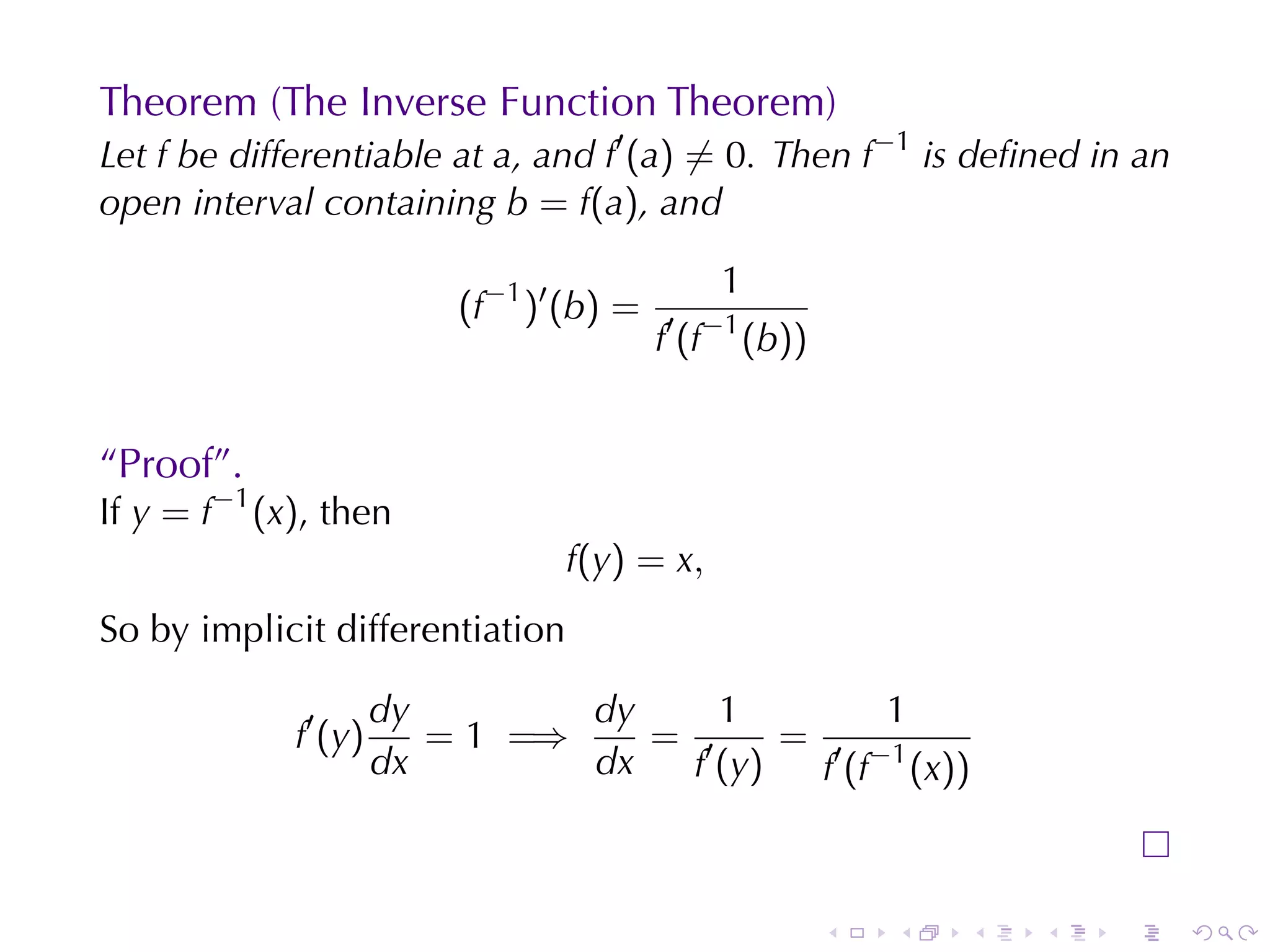
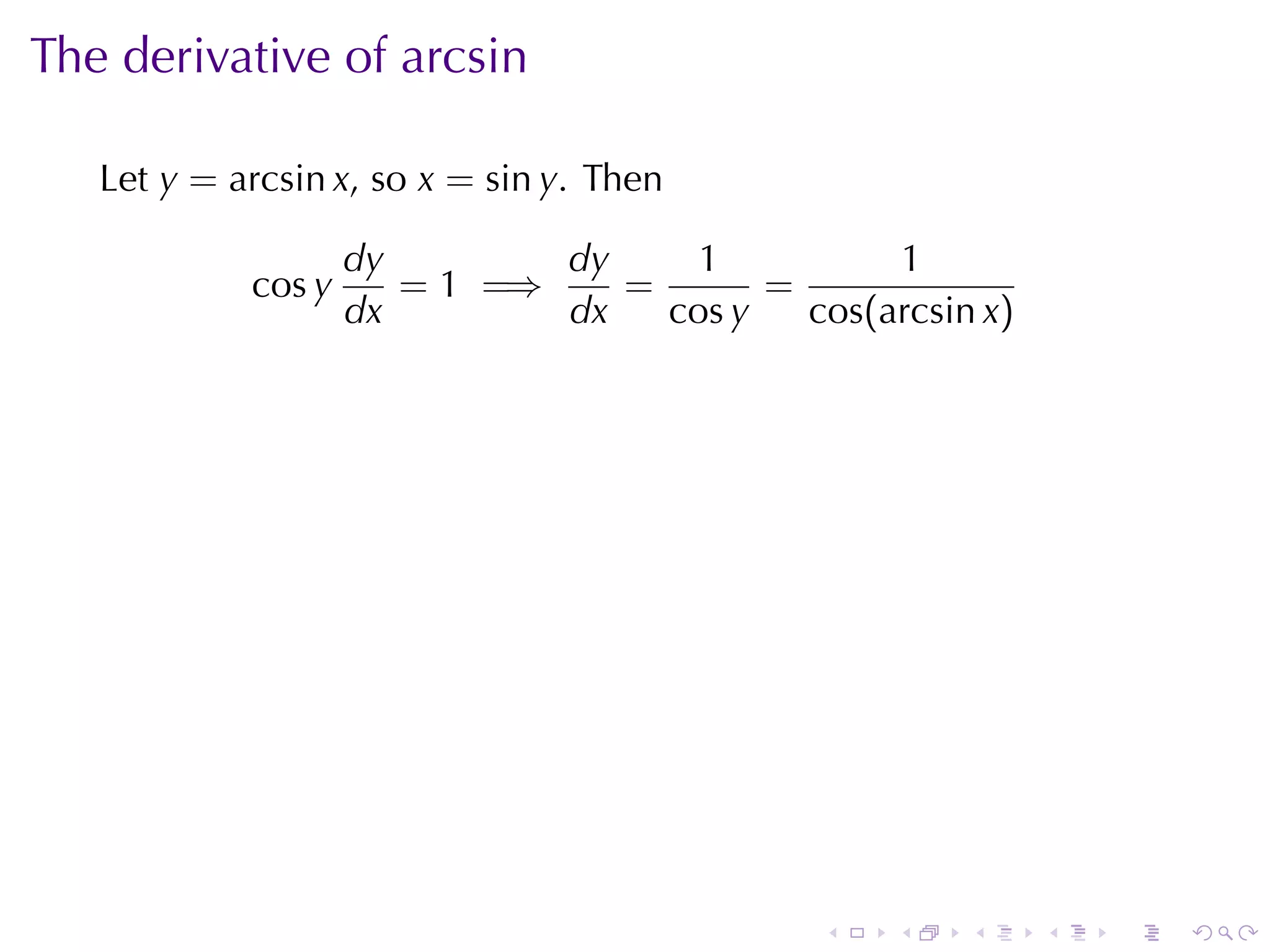
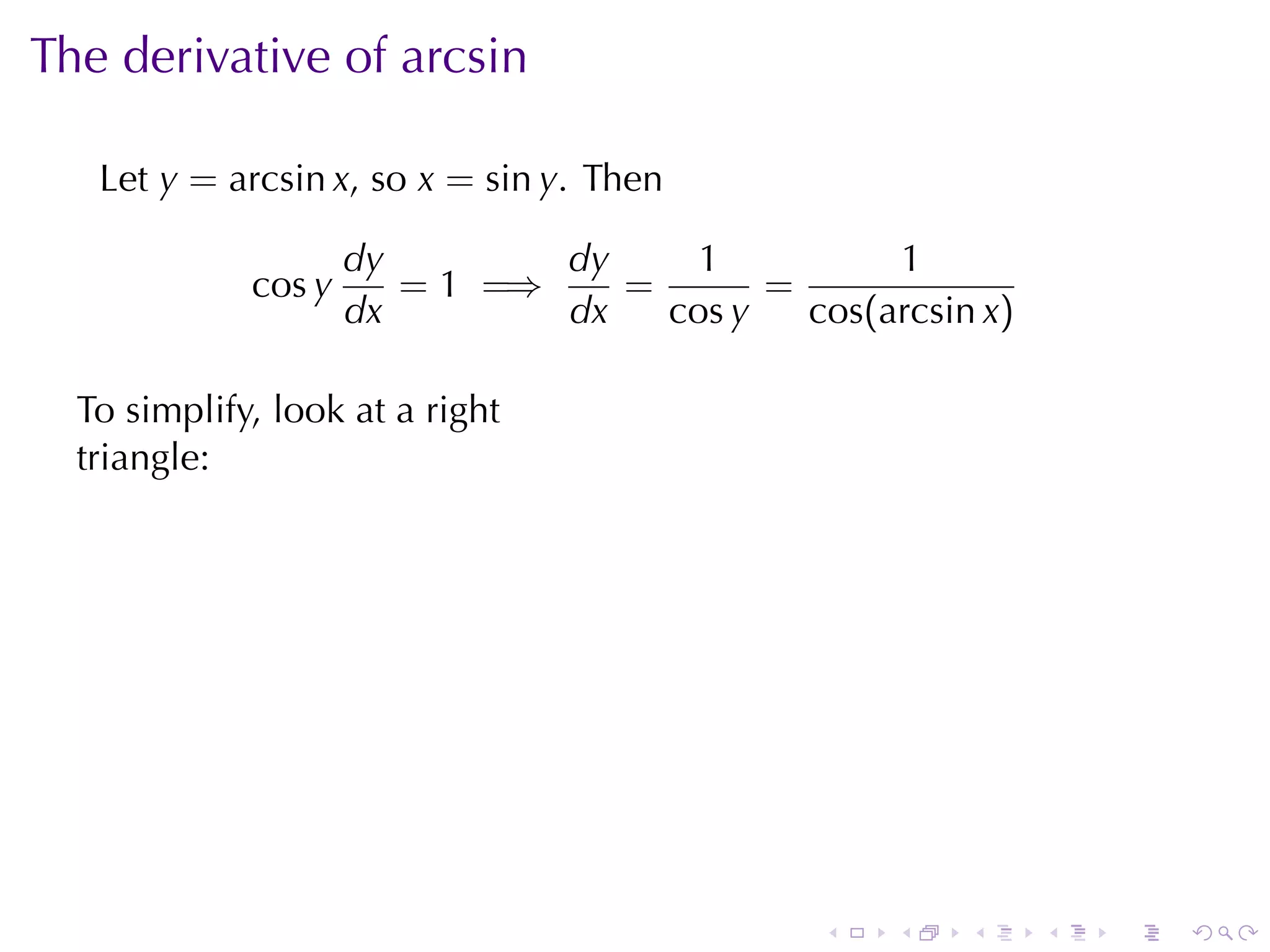
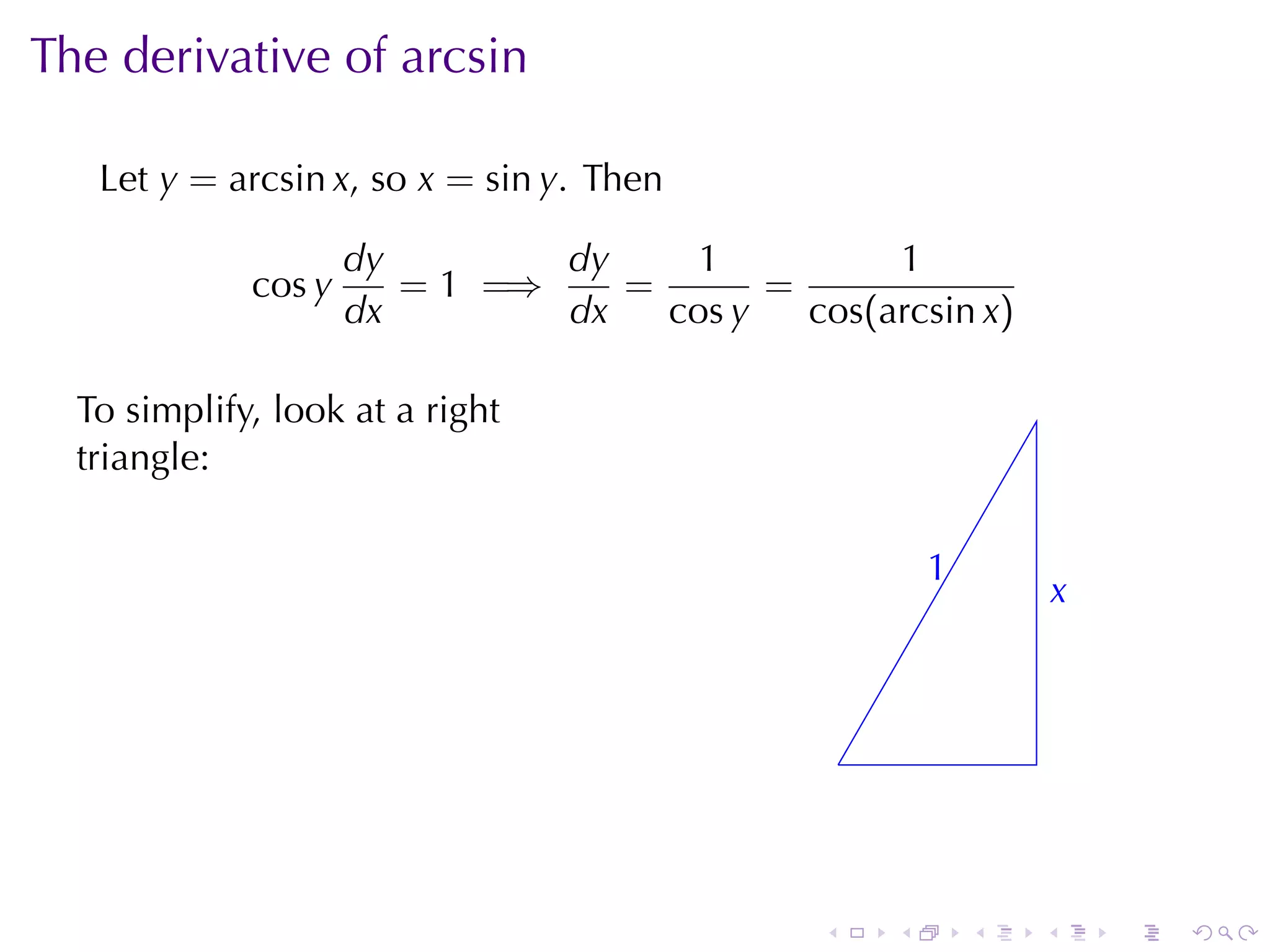
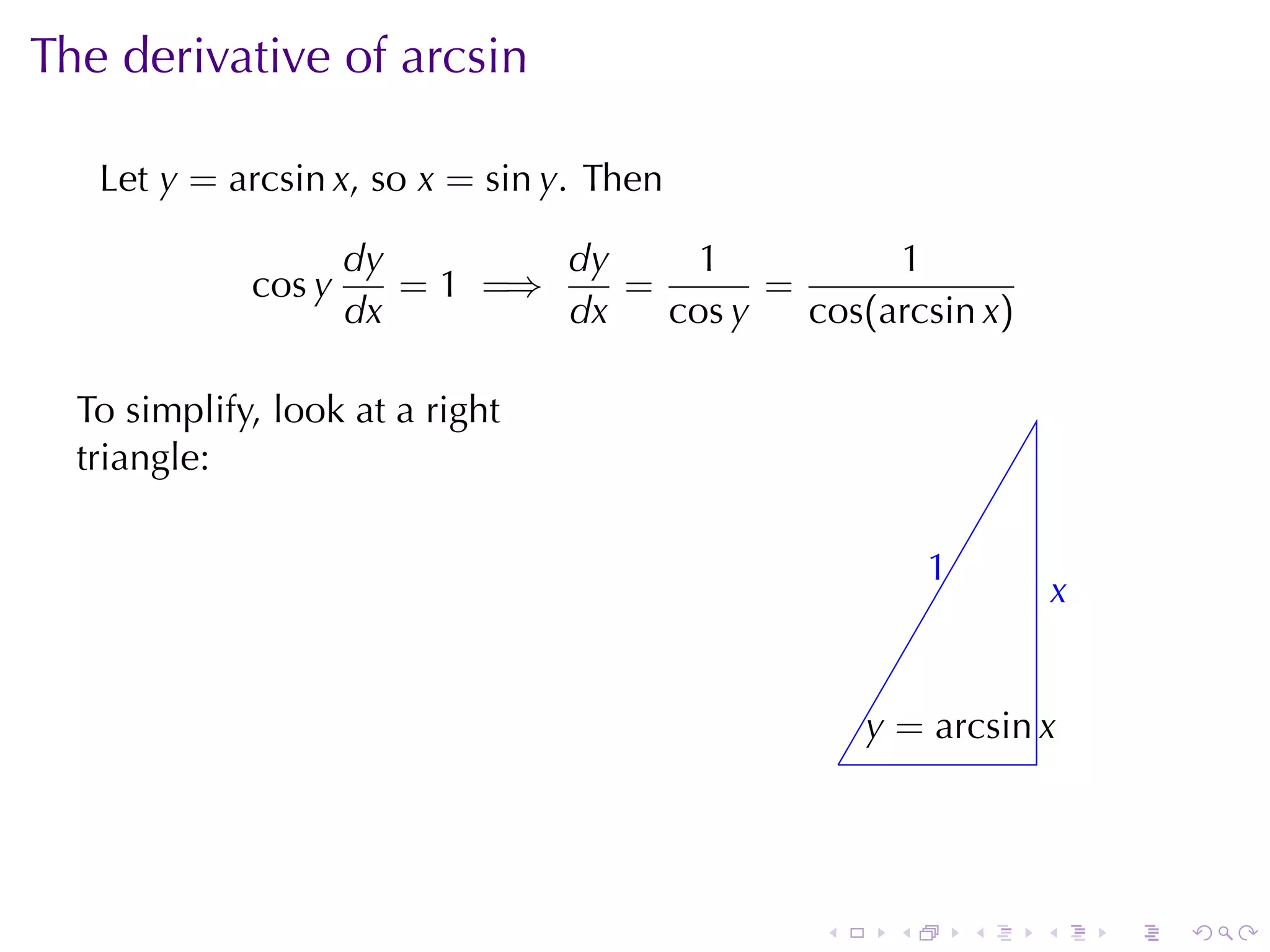
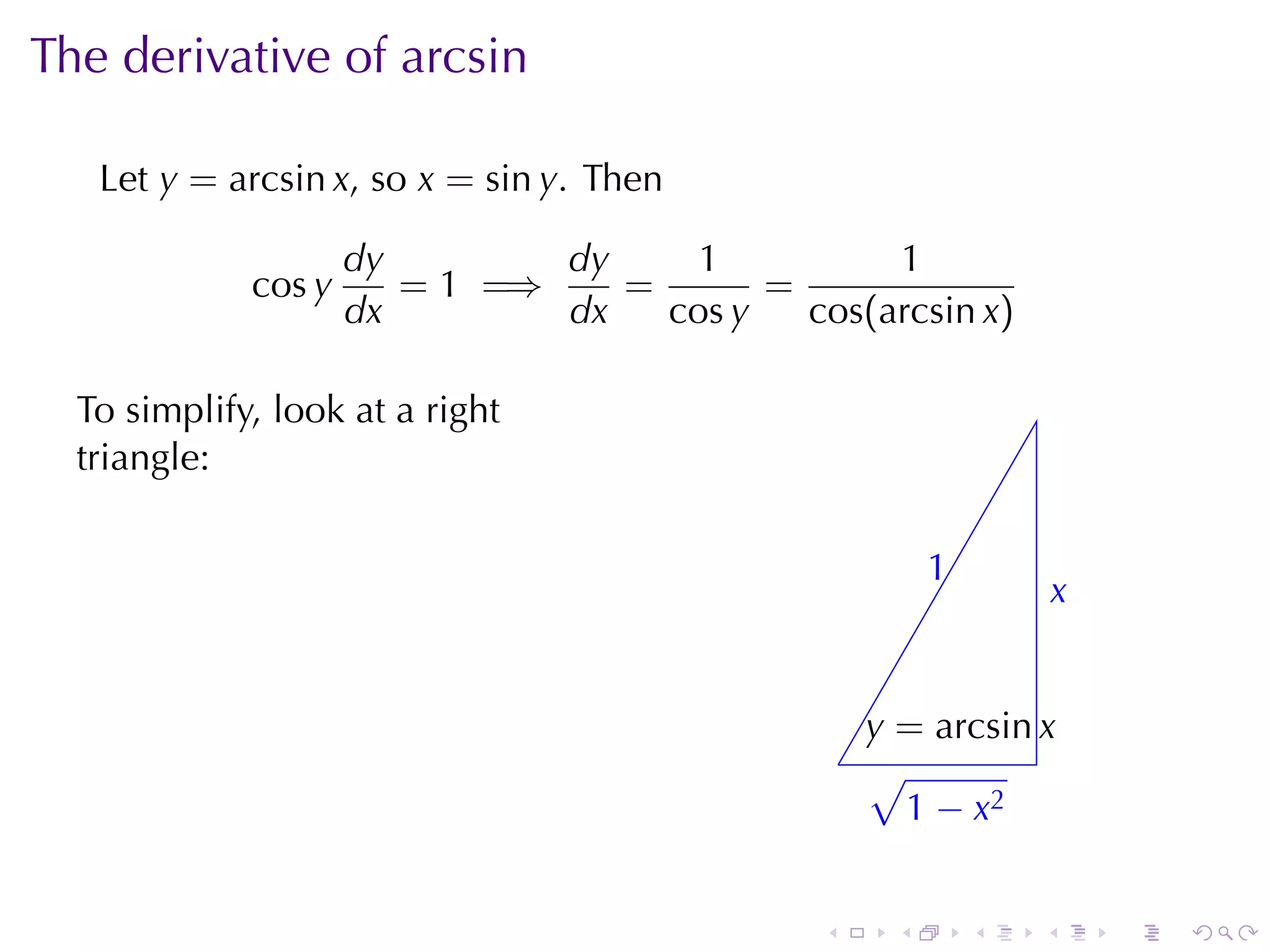
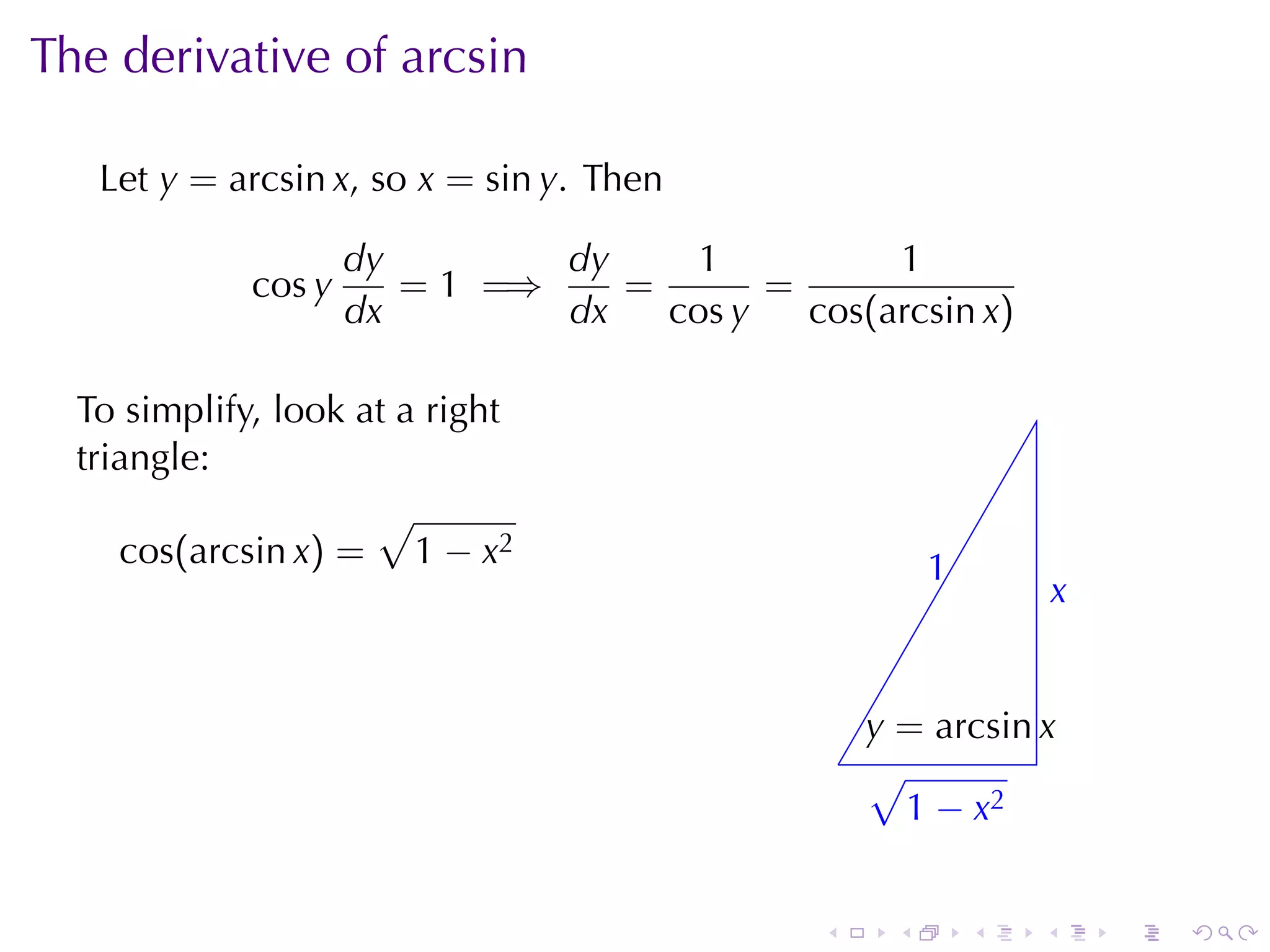
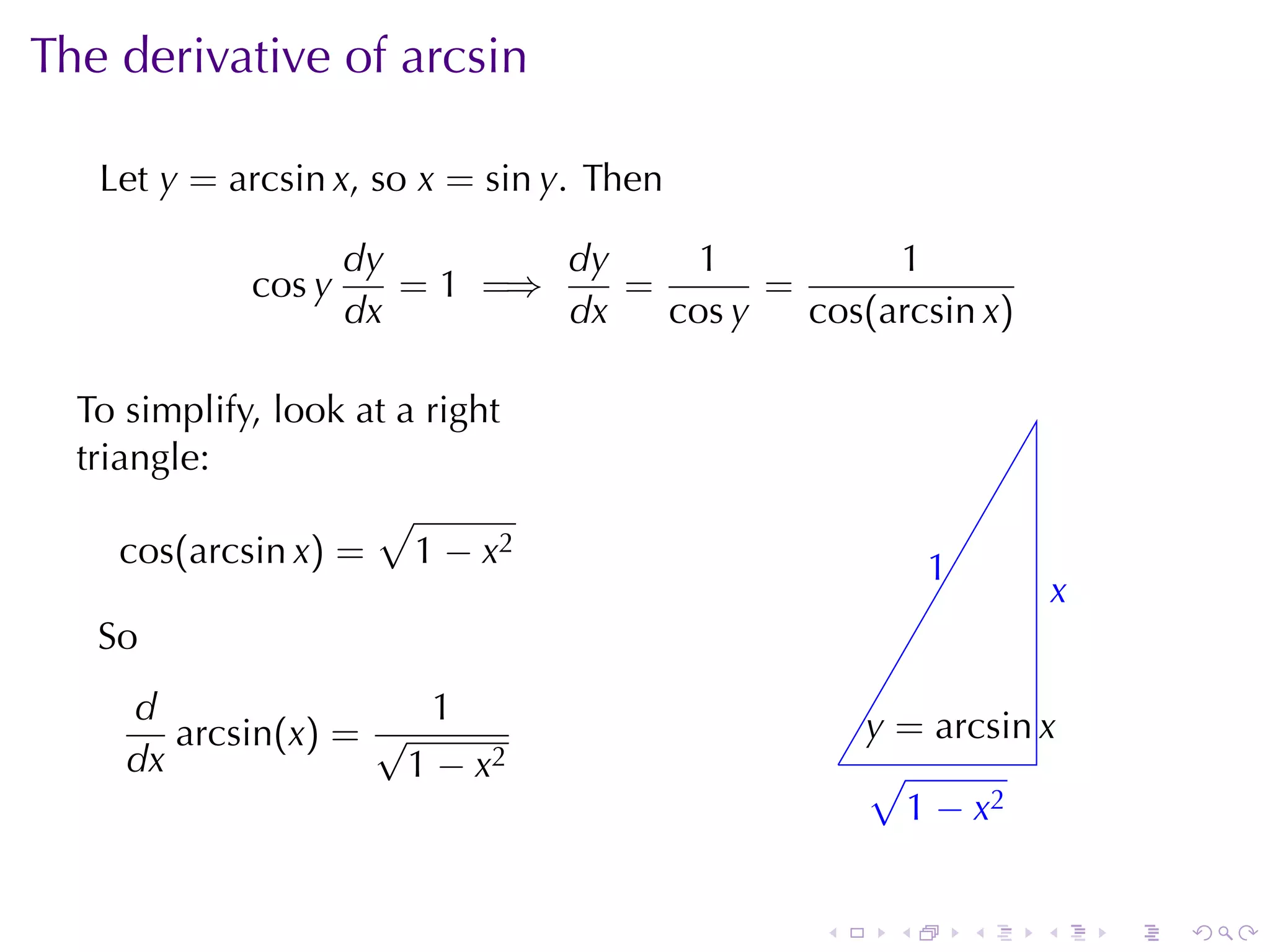
![Graphing arcsin and its derivative
1
.√
1 − x2
The domain of f is
[−1, 1], but the domain . . rcsin
a
of f′ is (−1, 1)
lim f′ (x) = +∞
x →1 −
lim f′ (x) = +∞ .
| . .
|
x→−1+ −
. 1 1
.
.
. . . . . .](https://image.slidesharecdn.com/lesson15-inversetrigonometricfunctionsslides-100323145757-phpapp01/75/Lesson-15-Inverse-Trigonometric-Functions-44-2048.jpg)
